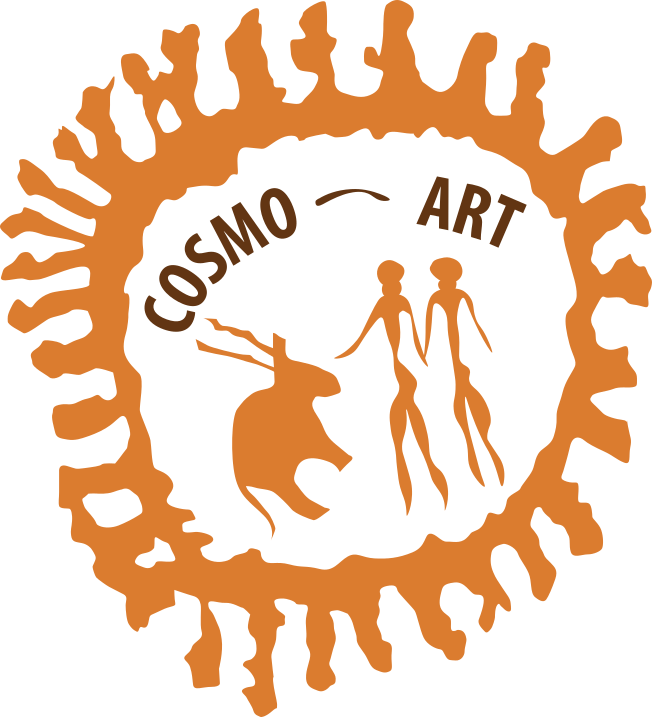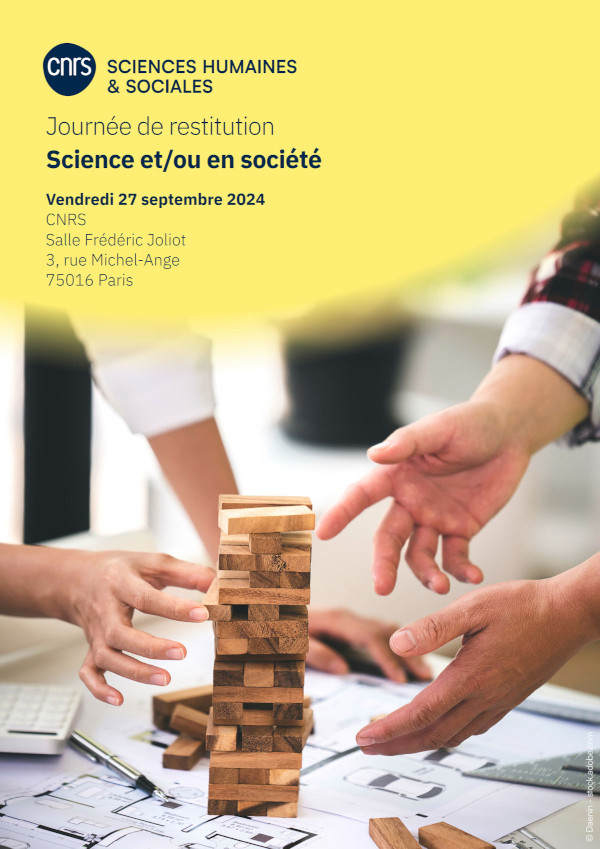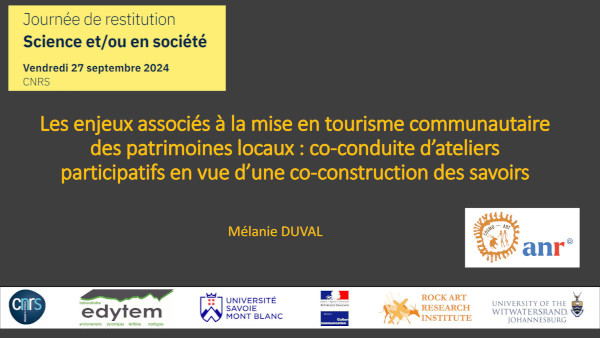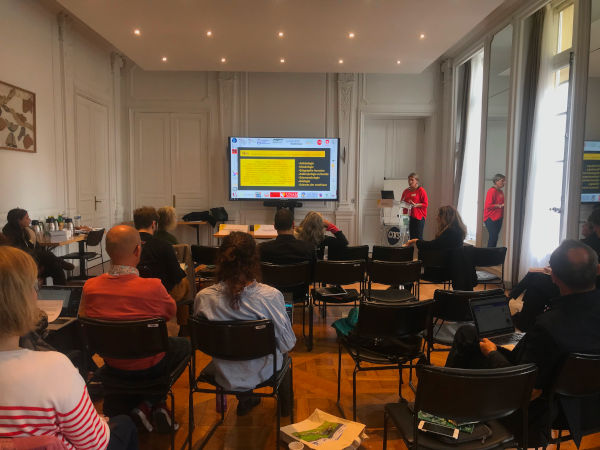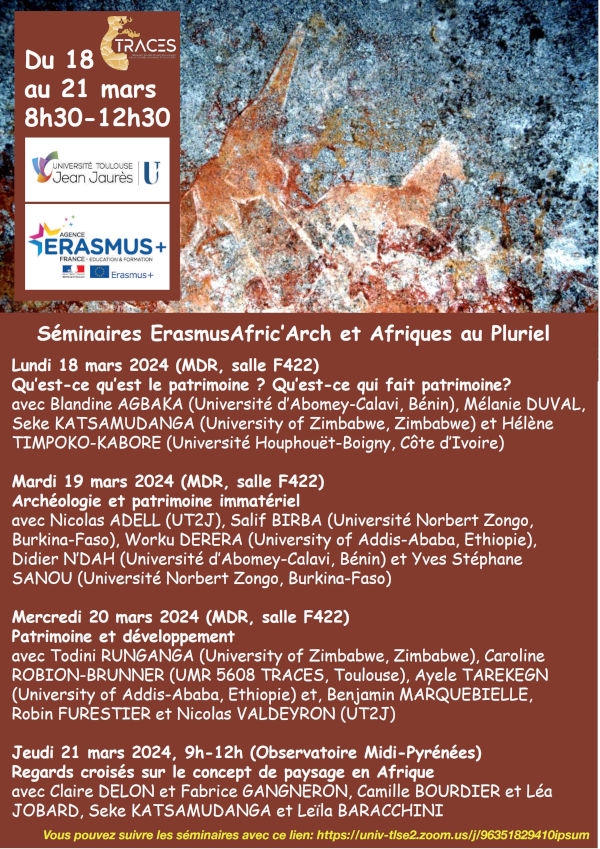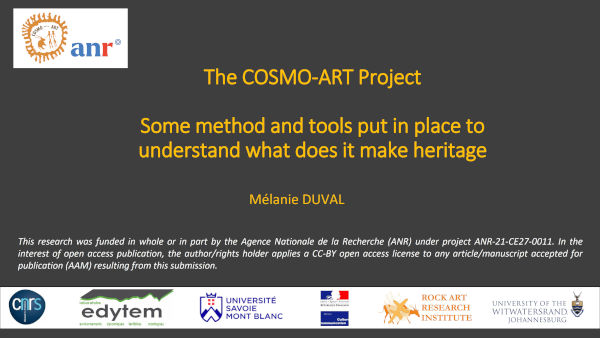What we do
The activities of the COSMO-ART team are shared between fieldwork, theoretical exploration, dissemination and outreach actions
For its operation and the achievement of the project objectives, COSMO-ART’s activities include meetings, fieldwork sessions and public outreach activities. The latter aim at communicating the scientific objectives of COSMO-ART, the different phases of the project and the results obtained.
5th biannual COSMO-ART meeting
- Chambéry, France
- 29-30 January 2025
- The Team
The annual meeting began with a review of the achievements of 2024. Highlights included fieldwork, student research projects, participation in various conferences and the dissemination of the COSMO-ART project through scientific presentations and publications.
Particular emphasis was placed on the RAHMSA 2 workshop, which took place from 27 November to 3 December in the Vézère valley, and which focused on the theme of ‘Presenting Rock Art Sites’. The event brought together 23 participants from several southern African countries and benefited from the expertise of 16 international trainers. Alternating between lectures and site visits, this workshop enabled participants to work on specific themes relating to the presentation and enhancement of rock art sites. Its success was made possible thanks to the support of more than 20 partners and additional funding.
Several students presented the progress of their master’s and doctoral theses, covering topics such as the historiography of rock art, conservation policies and the perception of rock art sites in different cultural and geographical contexts:
- Curtis Jeaven: Curtis presented the development of his conceptual framework and the data collected during his mobility in France (4 months in the Vézère valley), with the various interviews planned with guides working on different rock art sites;
- Juliette Barthélemy: Juliette presented the aims of her research, her analytical framework, the sites she is working on, the corpus she has compiled and the initial results, with an analysis by period;
- Hugo Quemin: Hugo presented what he has been doing since his arrival in Southern Africa at the beginning of November 2024, with a focus on research carried out in Namibia, particularly in the Brandberg and Omandumba areas;
- Antoine Latarge: Antoine returned to what he had been doing as part of the GeoExTour programme on the Gondwana Geopark project, analysing the problems associated with small-scale mining, and how this led to the development of his PhD project on the dynamics of mining in Southern Africa.
Finally, the agenda of the COSMO-ART final conference was discussed and a first programme of sessions was agreed. The conference is scheduled for the first week of December 2025 and will be hosted by Sol Plaatje University.
Preparing the next joint fieldwork in Namibia
- Chambéry, France
- 27-28 January 2025
- Benoît Caron, Mélanie Duval, Stéphane Jaillet, Stéphane Hœrlé & David Pleurdeau
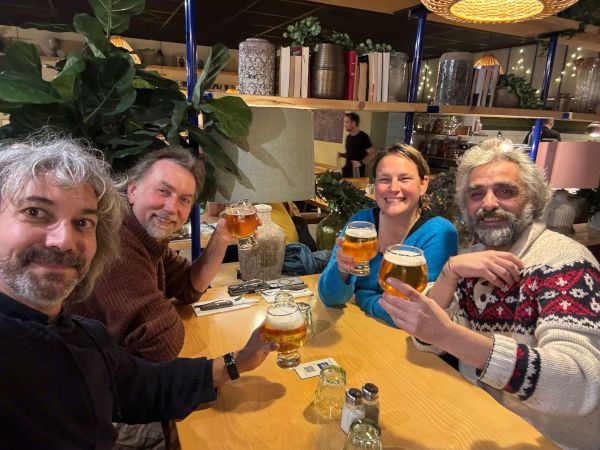
During this meeting, the upcoming joint fieldwork in Namibia was planned. The aims of this fieldwork will be:
- Continue the geomorphological work on the formation of rock art landscapes in the Erongo Mountains;
- Complete the systematic inventory of rock art sites in some parts of the Anibib, eTemba and Omandumba West farms;
- Precise the modes of tourism development in the Erongo and Spitzkoppe areas;
- Start Antoine Latarge fieldwork for his doctoral research within the GeoExTour project on the Gondwana Geopark.
4th biannual COSMO-ART meeting
- Chambéry, France
- 6 September 2024
- The Team
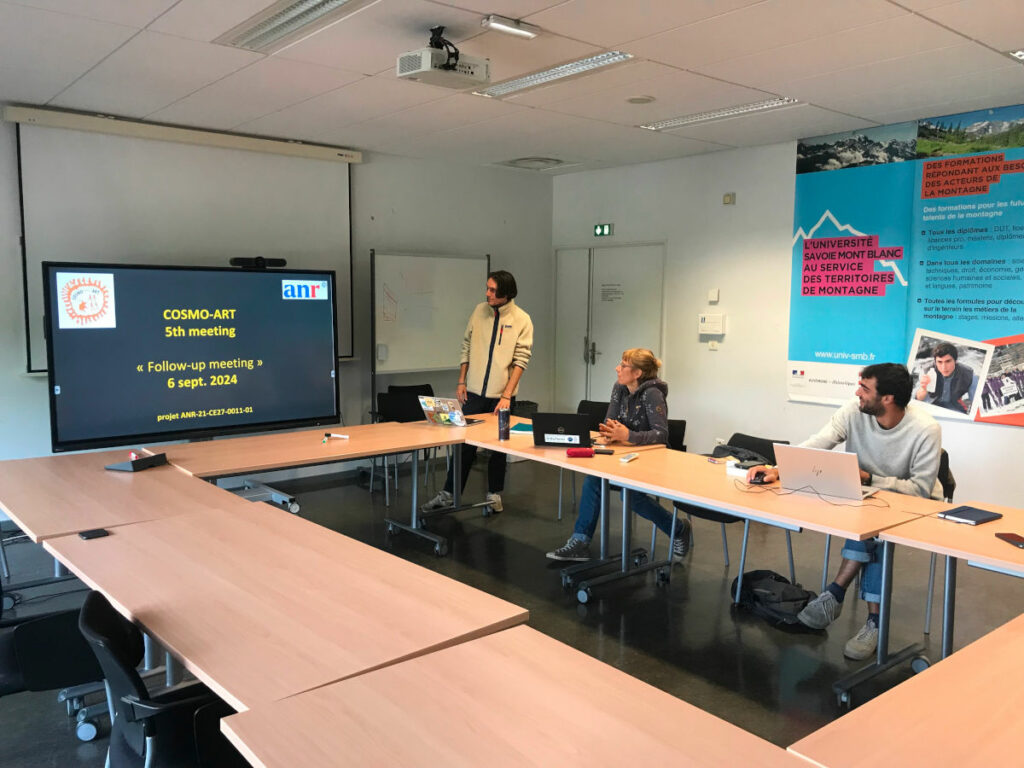
This biannual meeting was mostly held online, with only some participants gathering in Chambéry, at EDYTEM.
It was mainly devoted to:
- reports on the actions carried out in 2024;
- presentations by students who carried out their projects with COSMO-ART;
- discussions about next year’s actions.
Co-working on heritage issues with local communities
- Johannesburg, South Africa
- 12 March 2024
- Mélanie Duval & Hugo Quemin
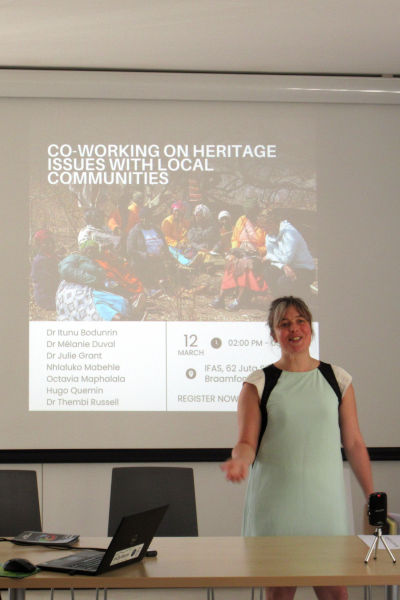

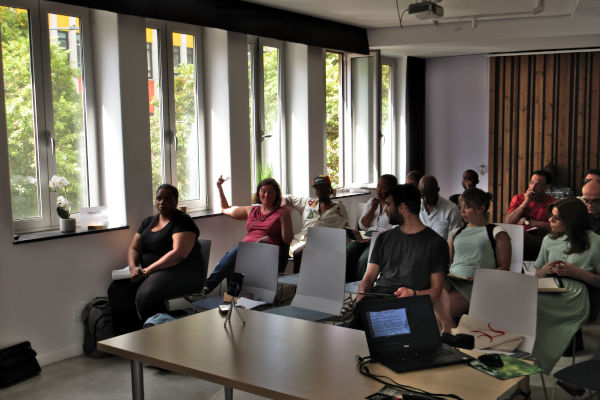
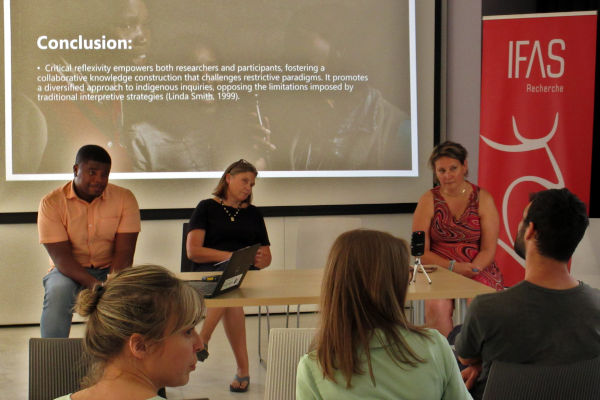
At the invitation of IFAS-Recherche, COSMO-ART organised a research seminar which took place at the IFAS premises. The theme of the seminar was: Co-working on heritage issues with local communities. The COSMO-ART team took the opportunity to invite colleagues and students from the Universities of the Witwatersrand and Johannesburg. The seminar lasted a full afternoon and included the following seven presentations:
- Reflections on working among communities in east and southern Africa by Thembi Russell (Senior Lecturer, Archaeology, University of the Witwatersrand, Johannesburg, South Africa)
- Conflicts around intangible heritage and developments – A case of Phiphidi Waterfalls by Nhlaluko Mabehle (PhD candidate, Archaeology, University of the Witwatersrand & Assistant Heritage Management Services Consultant, Digby Wells Environmental, Johannesburg, South Africa)
- Heritage and sustainable development: investigating the successes and failures of community-run public rock art sites in Southern Africa by Octavia Maphalala (MSc Archaeology, University of the Witwatersrand, Johannesburg, South Africa)
- Uses and abuses of community. Lessons from Wildebeest Kuil Rock Art Tourism Centre by Hugo Quemin (PhD candidate, Human Geography, Laboratoire EDYTEM, CNRS-Université Savoie Mont Blanc, France)
- Collaboration between communities and researchers: challenges and limits. Reflections based on the Places in Me project with the !Xun and the Khwe of Platfontein by Mélanie Duval (Researcher in Human Geography, Laboratoire EDYTEM, CNRS-Université Savoie Mont Blanc, France & Rock Art Research Institute, University of the Witwatersrand, Johannesburg, South Africa)
- Working with Locals: Experiences with South Africa’s Bushmen Communities by Julie Grant (Senior Research Associate and Specialist, Communication and Media, University of Johannesburg, South Africa)
- Critical Reflexivity in San Research by Itunu Bodunrin (Design Studies, University of Johannesburg, South Africa)
The discussions highlighted the importance of understanding the socio-spatial contexts in which research takes place. They also emphasised the need (1) to make the content of the research explicit, so as not to raise expectations that cannot be met, and (2) work over a long period of time, giving regular feedback to the communities involved on the progress of the research.
3rd biannual COSMO-ART meeting
- Chambéry, France
- 31 January – 2 Februrary 2024
- The Team
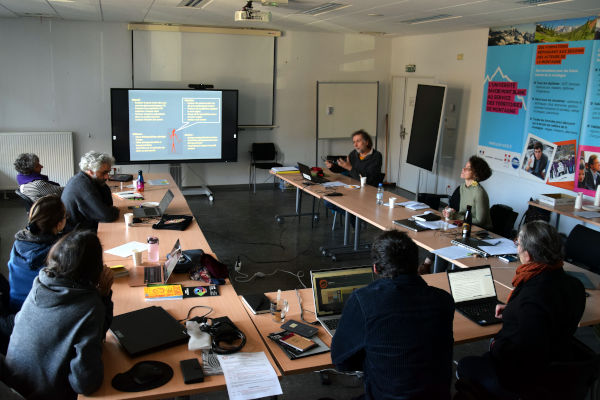
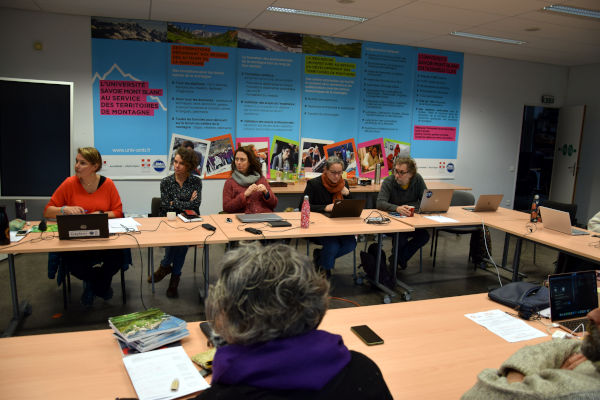

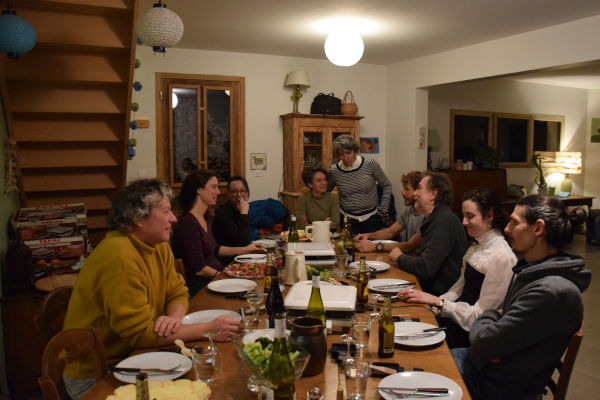

This biannual meeting was an opportunity to take stock of COSMO-ART’s activities as the project reaches its half-way point.
During the first half-day, the people who had joined the programme since the last meeting were introduced (Juliette Barthelemy, Benoît Caron, Curtis Jeaven, Annael Le Poullennec and Tshenolo Moletsane) and a summary of the 2023 activities was given, in particular the joint fieldwork in Namibia and the two exhibitions prepared by the COSMO-ART teams in Namibia (A Tribute to Rock Art in Namibia) and South Africa (Places in Me). Two COSMO-ART related activities were also presented: the first RAHMSA workshop (Documenting Rock Art, Namibia) and the Geoextour project, which aims to analyse how protection (landscapes, rock art) and extraction issues interact in the Gondwana Geopark (Namibia).
On Wednesday and Thursday morning, research works were presented by:
- Hugo Quemin: Master 2 on the rock art sites in the Erongo;
- Stéphane Jaillet, David Pleurdeau and Benoît Caron: geological and geomorphological work done in the Erongo;
- Curtis Jeaven: Honours research on how the exhibition Places in Me and its preparation was perceived within the Platfontein’s communities;
- Julien Monney and Laurent Bruxelles: spatial analyse of engravings and rock structures at Wildebeest Kuil;
- Anaïs Empereur-Buisson: Master 2 on rock art conservation at Wonderwerk Cave;
- Julien Monney and Stéphane Hœrlé: survey and spatial analysis of rock art the Erongo;
- Nadia Belaïdi: anthropology of law approaches to values.
Thursday afternoon was devoted to discussions around the notion of « values » and how to manage them within the project in order to achieve our goals of implementing a Cosmopolitan Approach. We had presentations by Marie Forget (values in human and social geography) and Gwendoline Torterat (values in archaeology approached through audiovisual anthropology), followed by a discussion chaired by Julien Monney on how to spatialise values in order to integrate them into a GIS tool.
Friday morning was a time of planning for 2024, with Hugo Quemin’s doctoral research and Juliette Barthélemy and Shanty Fisher‘s master’s theses that are already scheduled, as well as plans for other French and Southern African students. We also planned future fieldwork sessions, RAHMSA workshop (Presenting Rock Art, France) participation in international conferences and publications.
2nd biannual COSMO-ART meeting
- Chambéry, France
- 31 January – 2 Februrary 2023
- The Team
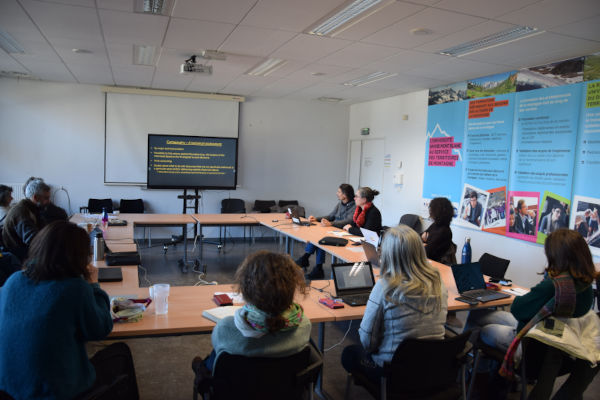
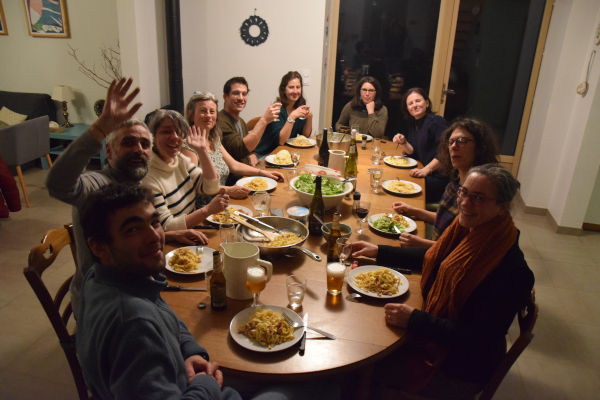
During this plenary meeting, we discussed the current and future research actions, while continuing the collective work around the notion of « values ».
The first half-day was dedicated to the presentation of the activities carried out during the first year of the COSMO-ART project. A special time was allocated to the new IRN RAHMSA project, a research project that aims to organise workshops on different aspects of rock art over the next five years. An update was also given on the work of the Honours and Masters students, who will start in spring 2023. Anaïs Empereur-Buisson presented her Master 2 project on the state of conservation of the Wonderwerk Cave paintings, and Hugo Quemin his Master 2 project on heritage logics in the Erongo massif. Lourenço Pinto also presented the lines of work that had been selected for several Honours projects by students at the Heritage Studies Department of the University of Sol Plaatje.
Following the reflections of the team on heritage values, Wednesday morning was devoted to this point. On the basis of the meeting held at the beginning of January, Mélanie Duval, Loïc Jeanson and Julien Monney presented several points that allows the exchanges to continue in a critical and structured manner, with the prefiguration of a first collective methodological article. The afternoon was reserved for the more detailed organisation of the two upcoming joint fieldworks for 2023, with the March/April joint fieldwork in the Erongo Massif (Namibia), and the June/July fieldwork in Kimberley (South Africa).
Finally, on Thursday morning, discussions were held with those involved in the photographic exhibition project, which is due to open in Platfontein at the beginning of July. Based on the work carried out by Leïla Baracchini using the photovoice method, this exhibition will consist of a selection of photographs taken and commented on by members of the Khwe and the !Xun communities on their relationship with the heritage of their landscape environment.
Seminar ‘values’
- Chambéry, France
- 5 January 2023
- Leïla Baracchini, Mélanie Duval, Loïc Jeanson & Julien Monney
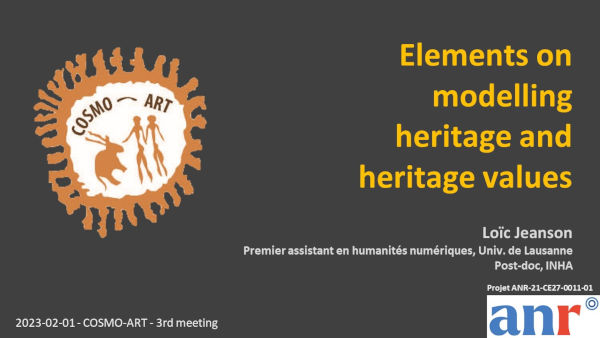
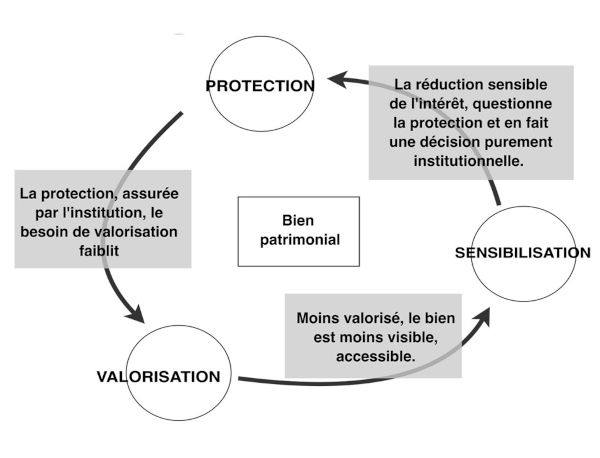
The aim of this one-day seminar was to continue, with a smaller group, the reflections on the notion and term « values » started in September 2022 and to prepare the continuation of the joint work on this aspect. Mélanie Duval, Loïc Jeanson and Julien Monney met in Chambéry for one day.
Having recently joined the COSMO-ART project, Loïc explained how he had approached the question of heritage values as part of his doctoral research and since then as part of his post-doctoral research. Specialised in the history of science and digital humanities, he presented his way of analysing discursive materials in order to identify the value registers mobilised by the enunciating actors as well as the characteristic elements of these value registers. Using modelling tools, he then explained how he links these registers and their characteristics in order to show the construction of the values on which any process of patrimonialisation is based.
1st biannual COSMO-ART meeting
- Chambéry, France
- 8 – 9 September 2022
- The Team
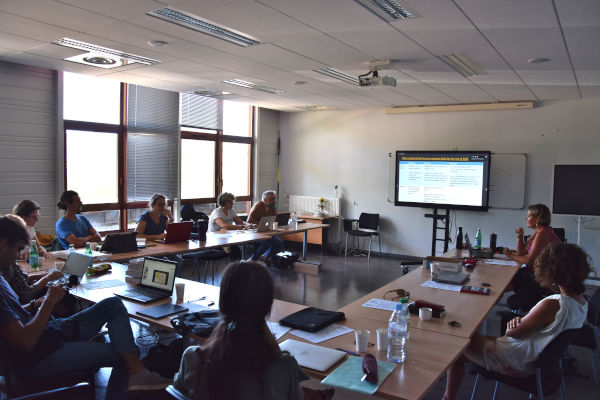
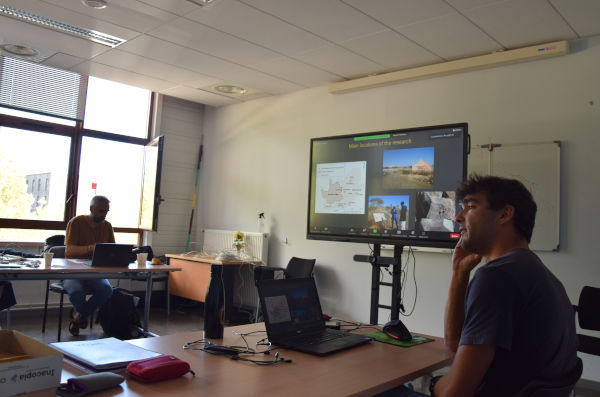
These two days of meetings and collective discussions were organised around several distinct times.
The first day was devoted to a more detailled presentation of the study areas selected for research within COSMO-ART, i.e. the rock art sites around the Kimberley region (Wildebeest Kuil, Wonderwerk cave, Nooitgedacht, Driekospeiland) as well as the rock art sites in the Erongo Mountains and Spitzkoppe area in Namibia. This presentation of the sites was enriched by the presentation of the first research work undertaken on the Wildebeest Kuil site with the presentation of Hugo Quemin’s Master 1 work in geography, the presentation of the first results of Leïla Baracchini’s post-doctoral work in social anthropology and the presentation of the Geographic Information System created by Julien Monney. These presentations were accompanied by in-depth discussions on the contributions of this comparative approach. The team also discussed the research actions planned for the rest of 2022, taking stock of the procedure for submitting data to the Data Management Plan and presenting a first draft of the website’s structure.
The second day was devoted to extensive discussions on the issue of « values ». At the heart of the COSMO-ART project, the question of the values attributed to rock art sites by different groups poses several challenges (epistemological, methodological, etc.). The planned biannual meetings of the COSMO-ART team will provide an opportunity to discuss and develop these issues. During this meeting, Jean-Jacques Delannoy presented his approach to this question of « values » in his own research in anthropo-geomorphology. Finally, the group discussed the application of video to the COSMO-ART project and the benefits of making a film about the research project and the main contributions of the research..
COSMO-ART kick-off meeting
- Chambéry, France
- 10 January – 2 February 2022
- The Team
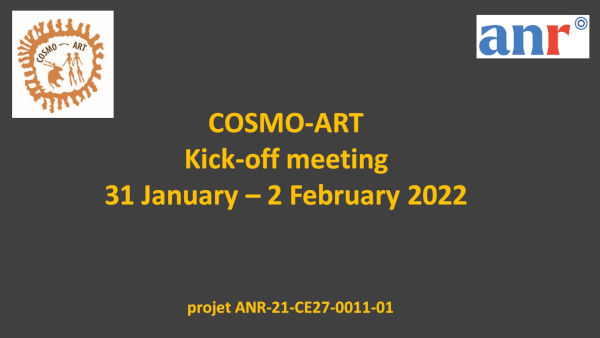
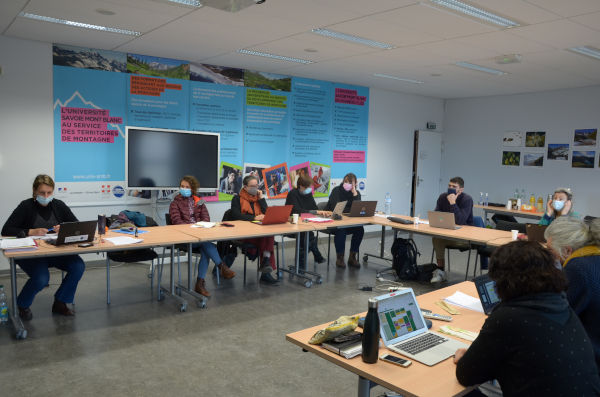
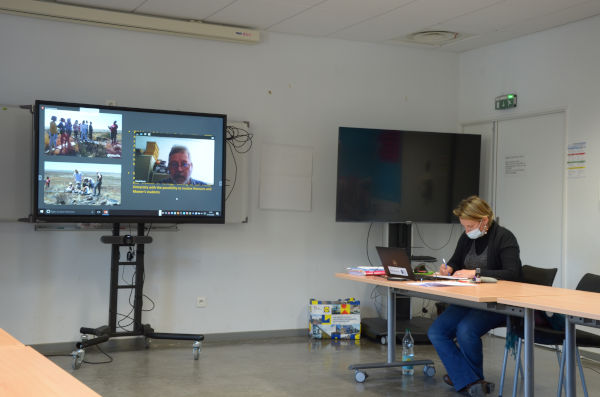
Over two and a half days, the team met both online and in person, making it easier for everyone to participate.
After the first half-day, during which each member successively presented their field of research and expertise, the objectives of the COSMO-ART research project were reviewed and discussed. Everyone was able to specify their involvement in the different research actions planned. The student work planned for the project was also discussed and refined, with an initial timetable for the four years of the project.
Part of the discussions also focused on the methods of organising the collective work, with the creation of a collaborative workspace, as well as discussions on the structuring of the Data Management Plan that is requested by the funding agency (ANR) and how the data will be made available.
For the partners present, staying in the same guesthouse allowed them to spend time getting to know each other, which is necessary at the start of a project that is both multiannual and multidisciplinary.
International Conference on Cultural Heritage in Africa – “A Dialogue on the Concept of Authenticity”
- Nairobi, Kenya
- 6 – 9 May 2025
- Mélanie Duval & Kaarina Efraim
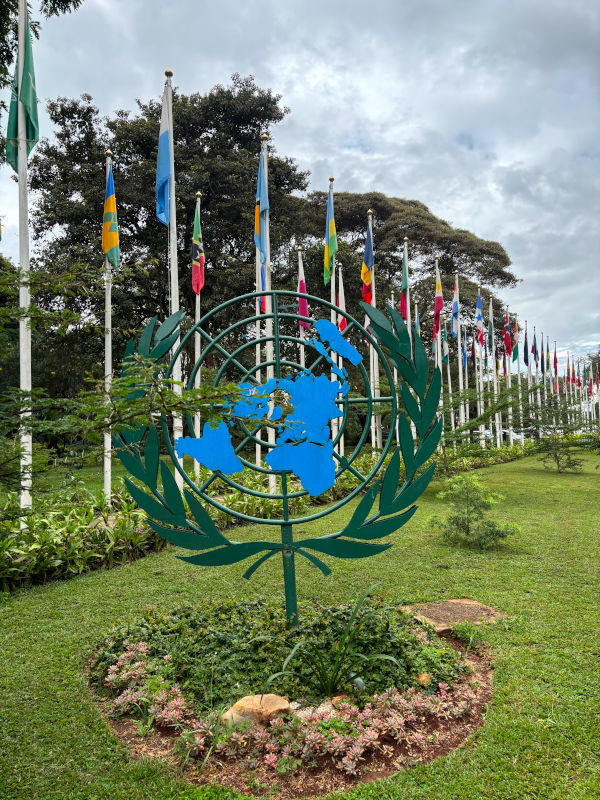
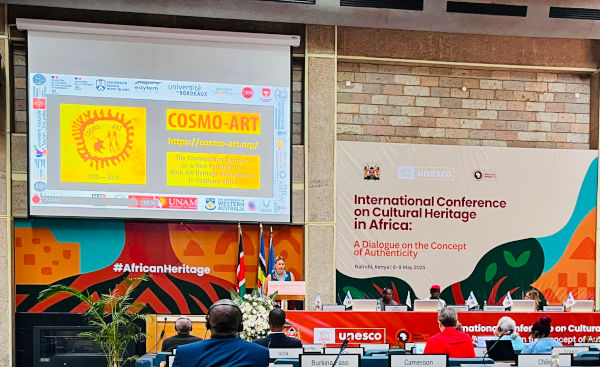

An international conference on cultural heritage in Africa entitled « A dialogue on the Concept of Authenticity » was held from 6 to 9 May 2025. The conference took place at the United Nations Centre in Nairobi, under the patronage of UNESCO and the Republic of Kenya, with financial support from Japan and France. Over 250 people attended, including representatives of UNESCO delegations from different countries, ambassadors and representatives of various heritage institutions on the continent, experts from different NGOs, representatives of local communities involved in heritage initiatives, and researchers involved in various research projects on the African continent. More than 80 presentations were made over the three and a half days. The following points were discussed across the board:
- All the papers highlighted the difficulty of grasping the concept of authenticity. Its constructed and plural dimension was discussed several times, concluding with the recognition of a dynamic and plurivocal process;
- Various approaches were presented with a view to making progress on this issue: holistic approach, heritage ecosystem approach, people-centred approach and cosmopolitical approach (with a talk by Mélanie Duval);
- Discussions also focused on how to document authenticity, and on the need to critically challenge how discourses are constructed: who determines what is authentic? This is all the more necessary because how authenticity is recorded can contribute to the reproduction of domination and power relations within communities. This issue has also led to discussions on how to take gender into account in heritage dynamics;
- The links between authenticity and decolonisation were also questioned, highlighting the need for a global and contextualised approach, as well as a critical reflection on what it means to ‘decolonise heritage practices’. These discussions also led to exchanges on the issues surrounding the restitution of cultural property by former colonial powers;
- The question of authenticity was also addressed in terms of its links, tensions and even conflicts with local development issues, be they tourism or urban expansion.
Presenting rock art in the uKhahlamba Drakensberg Park
- uKhahlamba Drakensberg, South Africa
- 11 April – 3 May 2025
- Curtis Jeaven
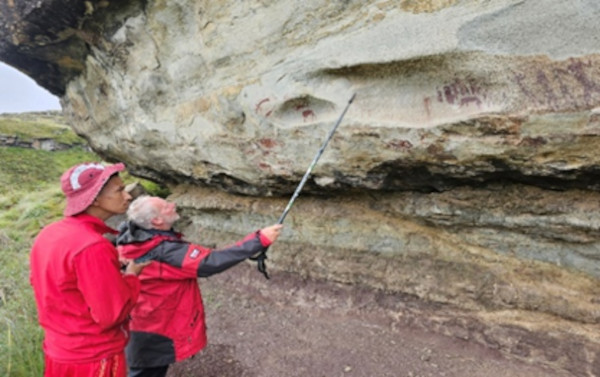
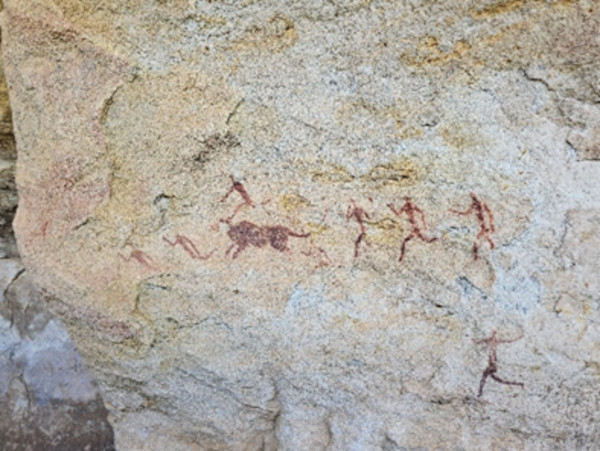
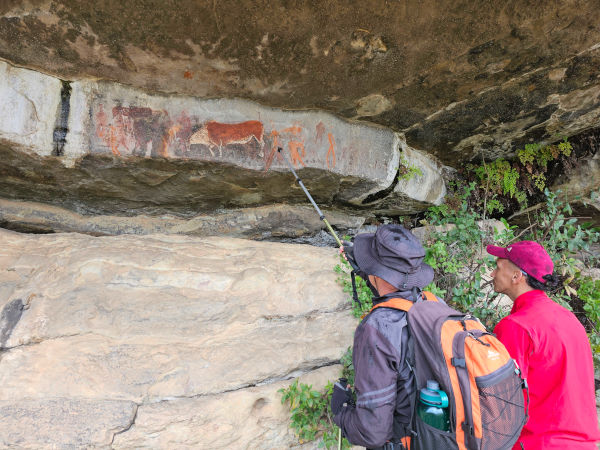
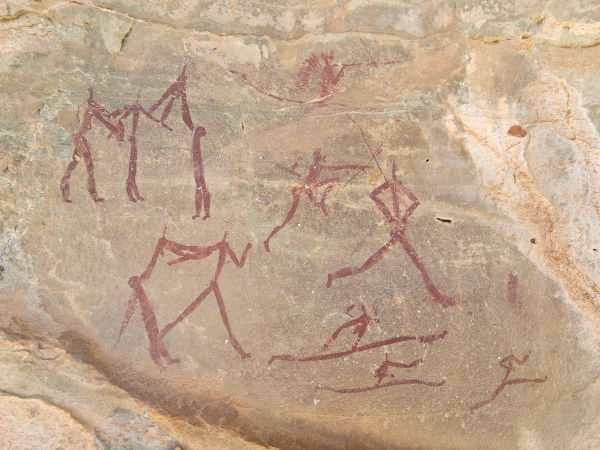
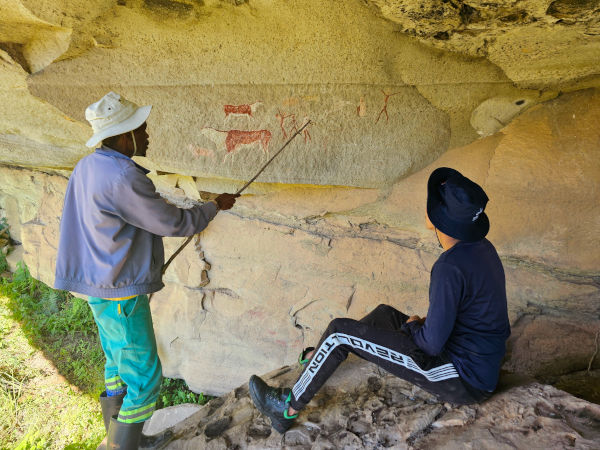
The uKhahlamba Drakensberg Park has about 40 000 rock art paintings which dates to about 3000 years ago. The region is considered to have one of the highest concentrations of ancient rock art in the world. The San rock art paintings, for the most part, are of spiritual significance and predominantly feature intricate fine line shaded polychrome depictions. The paintings often depict various human-like figures and animals such as the eland and horses.
On the 11th of April 2025 my research trip commenced in the southern parts of the uKhahlamba Drakensberg Park. To start with, I had visited three rock art sites close to the Underberg area. These includes sites situated on private farms. I was surprised to find that sometime farm owners have no idea that there is rock art within their properties. For instance, I visited a very interesting site on a farm, just about 500 m from the road. Yet, the site is barely visited by the public as it is situated on a restricted access private land. In the context of the above, one of the highlights was partaking in a heritage excursion to the Pornographic Rock Art Shelter – one of the lesser-known sites situated in the Garden Castle. This site has some remarkable paintings of San rock art, including a series of hunting scenes with some remarkable animal and human-like figures.
I explored the Himeville Fort and Museum in the Underberg. It is a large complex of buildings which includes a house with exhibitions. One of the exhibit rooms has an exhibition dedicated to the rock art of southern KwaZulu-Natal. The exhibition includes information of the San people as the artists of the Rock art, and depictions of rock art from various sites in the southern parts of the uKhahlamba Drakensberg Park. Overall, it offers a glimpse into the daily lives and spirituality of the San people through the rock art paintings.
Additionally, I had a tailor-made rock art tour at the KwaZulu-Natal Museum in Pietermaritzburg. The tour guide took me on a journey of discovery, mentioning the San people as hunters of southern Africa and explaining the history of the rock art paintings. For example, there is a panel with citations explaining how the mixtures were used to get different colours for the San paintings. Red from iron oxide is the most used colour on the shelters. Moreover, there is a Cave-like replica of specifically selected replica rock art from the northern Drakensberg and the “Elephant Man Panel” from the Mohwabane Shelter in the Ebusingatha area of the Amazizi Village.
Game Pass Shelter in the Kamberg Rock Art Centre boasts some of the most remarkable rock art of the uKhahlamba Drakensberg Park. It is the site which has given European recognition to San rock art of the uKhahlamba Drakensberg Park. I went on a guided tour to the Game Pass Shelter via the Waterfall Shelter. Moreover, I had interviewed two of the local guides who lives in the village at Kamberg.
Along with Game Pass Shelter, Battle Cave is one of the most decorated rock art sites in the uKhahlamba Drakensberg Park. Situated in the central part of Drakensberg, Battle Cave is about a 5.7 km walk from the Injasuthi Camp. The shelter is one of the most protected sites and has a fence which makes it inaccessible without a guide. I went on a guided tour with Drakensberg Walking Excursions whereby an independent Accredited Amafa KwaZulu Natali Guide provided a full interpretation of the rock art. In the 1980s, Aron Mazel recorded about 1 200 paintings at Battle Cave, however many of these paintings have deteriorated over time. There are still some must-see paintings at Battle Cave including the panel of paintings which the cave was named after.
My research trip concluded in the northern parts of the uKhahlamba Drakensberg Park on the 3rd of May 2025. I had guided tours to rock art sites such as the Mohwabane Rock Art Shelter, Mkhosheni Rock Art Shelter and Sigubudu Rock Art Shelter. These sites are in the Amazizi Village. Moreover, I had interviewed three local tour guides from the village who do guided tours in the northern Drakensberg.
Joint fieldwork in Namibia
- Namibia
- 5 – 22 April 2025
- Benoît Caron, Mélanie Duval, Stéphane Jaillet, Lourenço Pinto, David Pleurdeau & Hugo Quemin
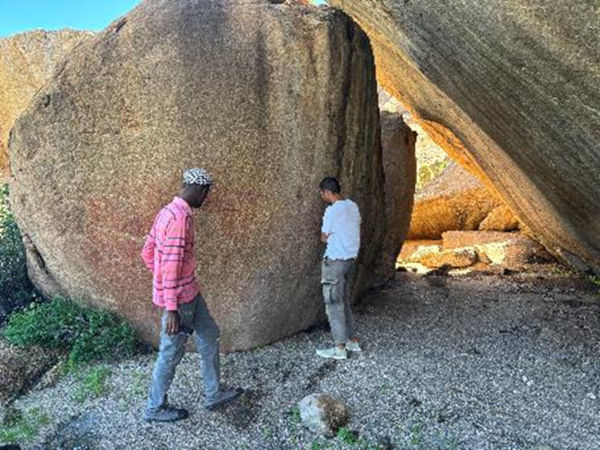
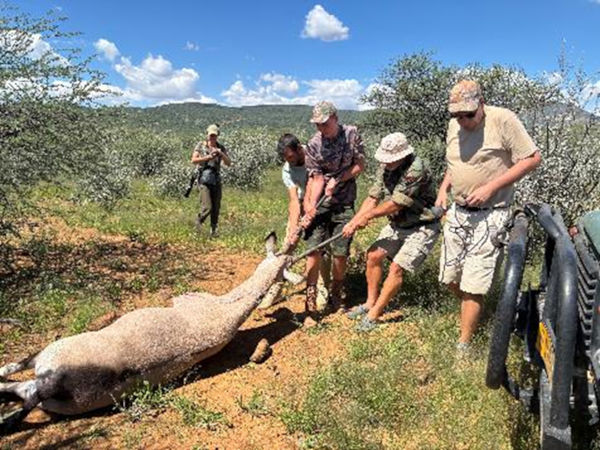
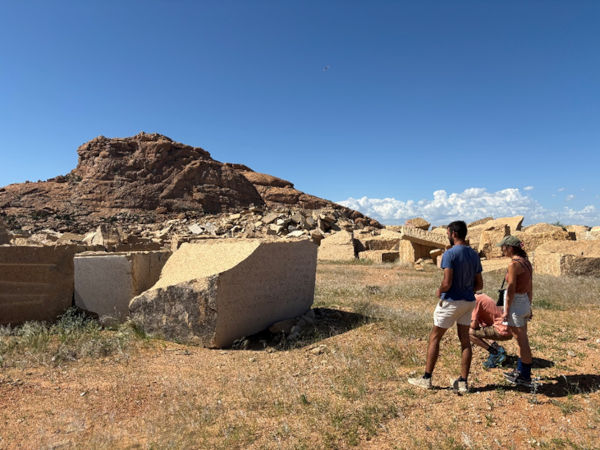

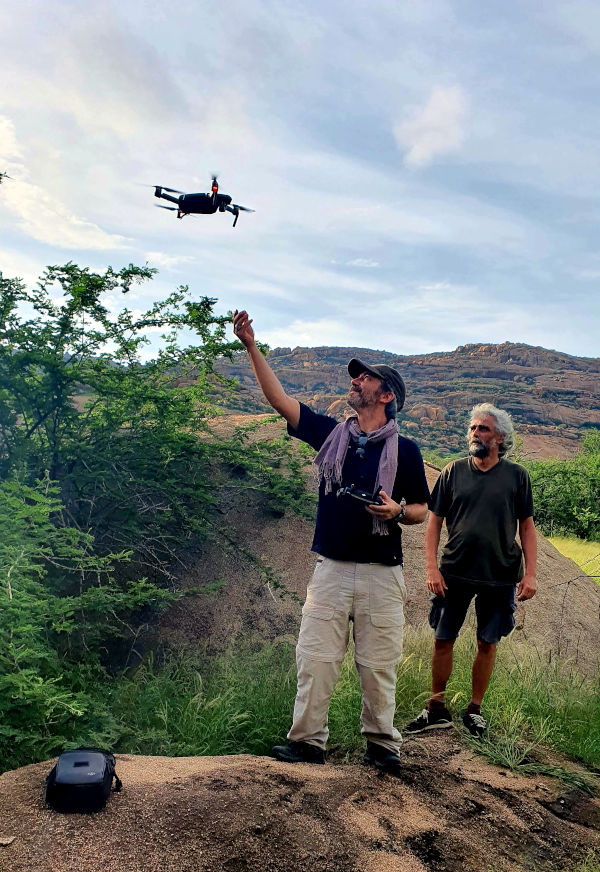
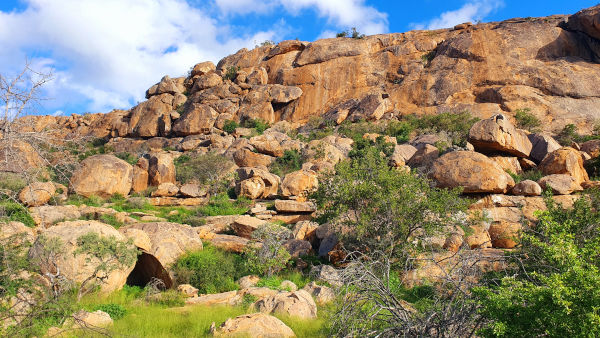

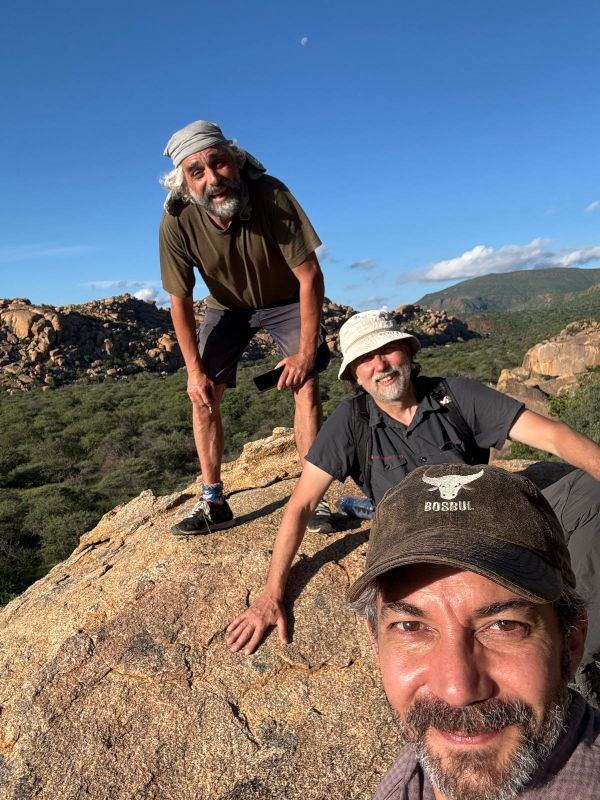
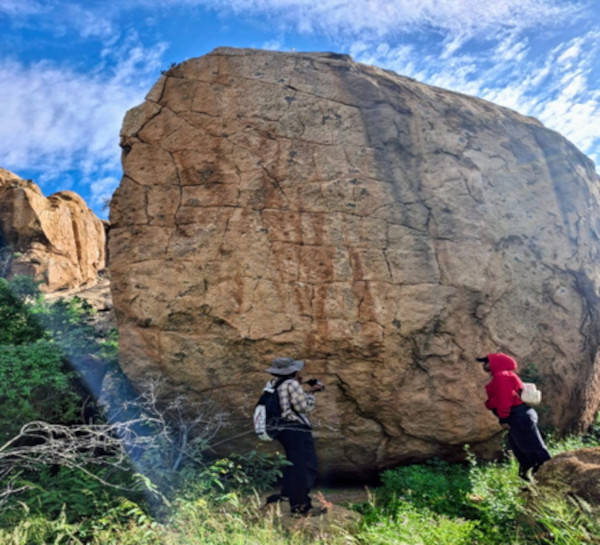
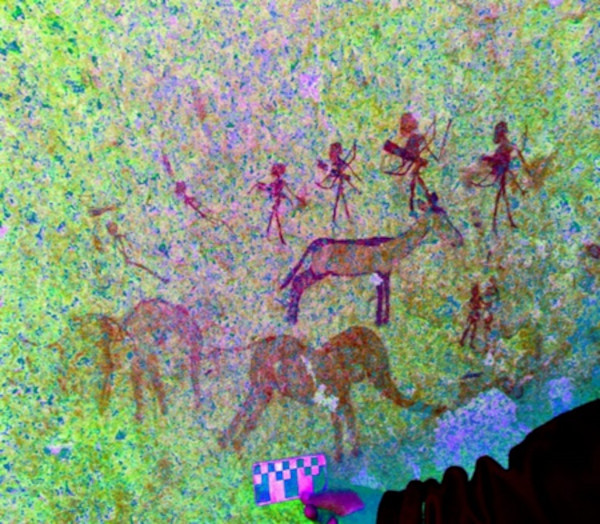
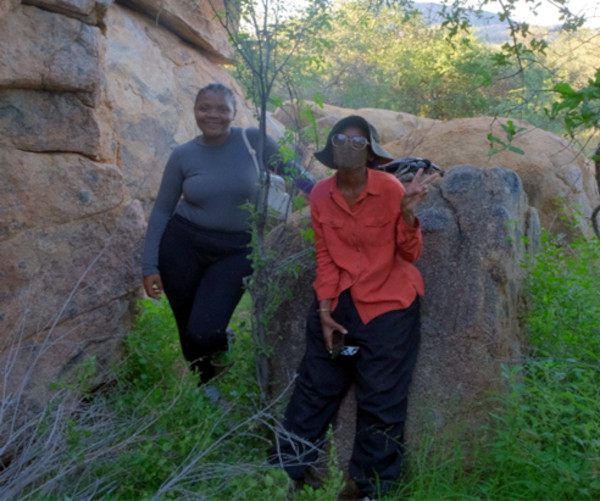
This fieldwork session gathered together 3 COSMO-ART teams.
Human and social sciences
This team organised its work into three phases:
- Data collection in the Erongo Mountains: As the COSMO-ART project is nearing its end, the aim of this fieldwork was to supplement the previously collected data in order to complete the analysis of the interplay of stakeholders in the massif. Additional interviews were conducted with landowners living in the ‘commercial land’ area of the mountains, and visits were made to rock art sites in the ‘community’ area and the Tubusis village. Additionally, observations enabled us to understand the issues associated with hunting tourism, which complements activities involving the discovery of rock art sites. This included the types of practices involved, the economic benefits and the network of stakeholders. Finally, we visited again a number of rock art sites open to tourists, with the aim of analysing the comments made about them. All the data collected since 2022 was taken into account;
- Data collection in the Brandberg massif and at Spitzkoppe: Spending a few days in Uis enabled us to take a closer look at how tourism is organised in the Brandberg massif, and in particular how visitors can visit the rock art sites in the various gorges. Data collection has enabled us to examine in greater detail the discrepancy between the interest of the rock art sites in these adjacent gorges and the fact that they are not promoted to visitors, highlighting the importance of training guides, who often come from all over Namibia and have only a very mediocre knowledge of rock art sites in the Brandberg. New observations were also made at Klein Spitzkoppe site. They enabled us to assess the co-spatiality between 1/ rock art sites not documented by the authorities, 2/ activities of small-scale miners and 3/ large-scale marble quarries. Finally, a stopover at Spitzkoppe enabled us to complete our observations of the work of the guides in the direction of the rock art sites open to tourism. All in all, our knowledge has been consolidated, and most of the data collected will be used in the planned articles.
- Windhoek – additional interviews and conference at FNCC: Additional interviews were conducted with two people involved in organisations representing San communities in Namibia, both in what remains of WIMSA (an NGO that was very active in the years 2000-2010 on the rights of San people throughout Southern Africa) and in an embryonic San Council in Namibia. An additional interview was also held with one of the National Heritage Council’s project managers. This interview was very useful in contextualising the data collected earlier, and provided some very interesting insights, particularly into the issues surrounding the development of tourism at rock art sites in the Brandberg massif. Finally, on the afternoon of Tuesday 22 April, at the request of the Franco-Namibian Cultural Centre (FNCC), a lecture was given on the issues involved in the COSMO-ART and RAHMSA research programmes, with a focus on the tourism of rock art sites in Namibia and the ways in which local communities are involved. The conference was followed by a round table on the recognition of community practices in the management
Archaeology and geomorphology
Following the 3D survey conducted in 2023, additional acquisitions were required to create comprehensive, multiscale 3D models of several rock art sites in the Erongo Mountains. The aim was to produce point clouds with resolutions adapted to three nested scales:
- 1/ for the site (100–200 m), drone surveys were used to cover the area of interest;
- 2/ for the shelter (10–50 m), lasergrammetric surveys were carried out using a terrestrial LIDAR to produce point clouds with sub-centimetric resolution;
- 3/ finally, for the rock wall, a photogrammetric survey was carried out using a full-frame digital camera.
All the 3D datasets were then assembled into a single model referenced by the drone survey and geometrically accurate thanks to the lasergrammetric survey.
Data from the two 2023 and 2025 fieldwork sessions are currently being processed. Eventually, seven sites rich in rock art will be surveyed: Ekuta Orongo, Phillip’s Cave, Echo Rock Shelter, Leopard Cave, Seal Rock Shelter, Fackelträger Rock Shelter, and Priest Rock Shelter. Initially, a data paper is planned, followed by another proposing a geomorphological analysis of the formation of these unusual ornate shelters.
Rock art
The aim of the fieldwork was to prospect the Omandumba West farm, record new sites, and obtain accurate GIS information for new and existing sites. This builds on fieldwork carried out in 2023 and 2024. This year, the COSMO-ART team was joined by Omphile Taele, a Master’s student in the Department of Heritage Studies at Sol Plaatje University, and Hilka Naambo Josef, a research intern at the National Museum of Namibia.
This field season was very successful, enabling us to document and precisely locate numerous new rock art sites on the farm. This wealth of data opens up several new avenues for future research, including, for example, the distribution of rock art sites and the importance of access to water, as well as stylistic analyses focusing on identifying specific figures in the paintings or on the representation of the human body.
Co-creating sustainable community heritage tourism
- Gauteng & Limpopo, South Africa
- 24 March – 2 April 2025
- Mélanie Duval, Lourenço Pinto & Hugo Quemin
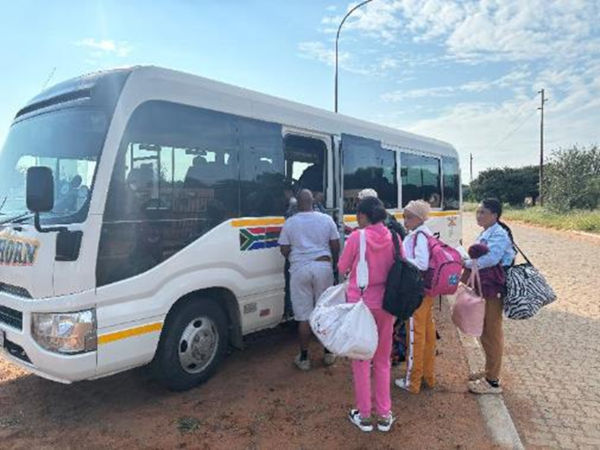

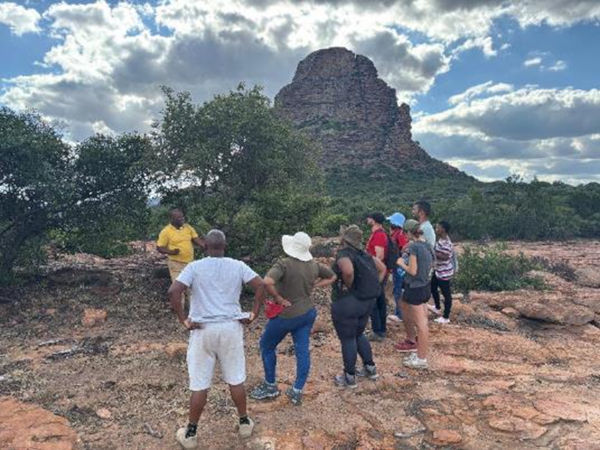
As part of the co-creation initiatives of the COSMO-ART project, this fieldwork was coupled with the workshop « Towards Sustainable Community Heritage Tourism ». This travelling workshop enabled a group of 30 participants (21 Khw and !Kun community members from Platfontein, 3 students from Sol Plaatje University, 5 tutors and one photographer) to observed how community-based tourism is organised in three places where local communities play a key role in the success of such initiatives:
- A backpacker run by members of the community in Soweto: Lebo’s Backpackers;
- A homestay tourism project involving tourists staying with local people: Makushu village (Limpopo);
- A community tourism project constructed around rock art sites on the Makgabeng Plateau (Blouberg Municipality, Limpopo).
Following the field trip, a series of roundtable discussions were held to help participants share their observations and consider how certain elements of these initiatives could be adapted or transferred to the Platfontein context.
Southern African Montain Conference and management issues
- Drakensberg, South Africa
- 17 – 20 March 2025
- Mélanie Duval, Antoine Latarge & Hugo Quemin
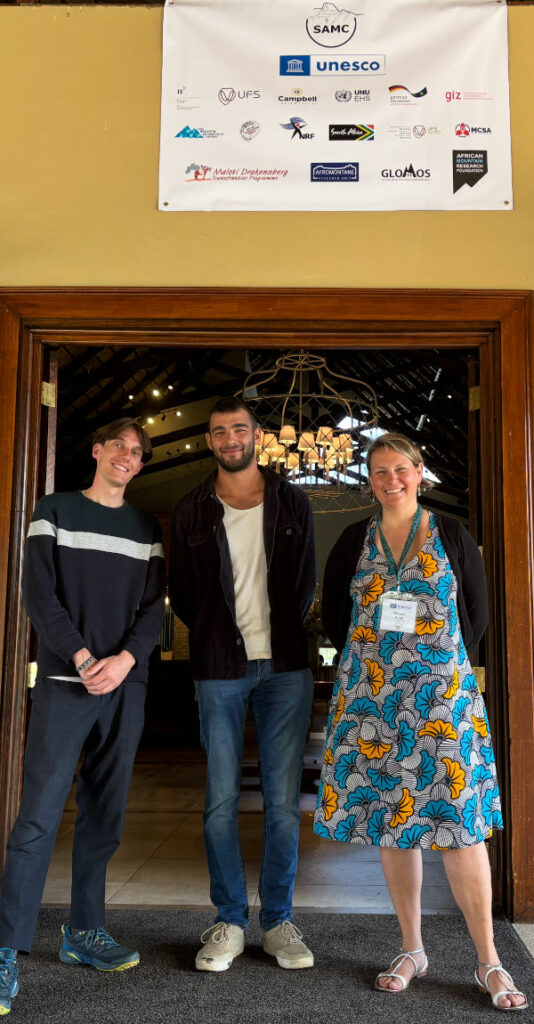
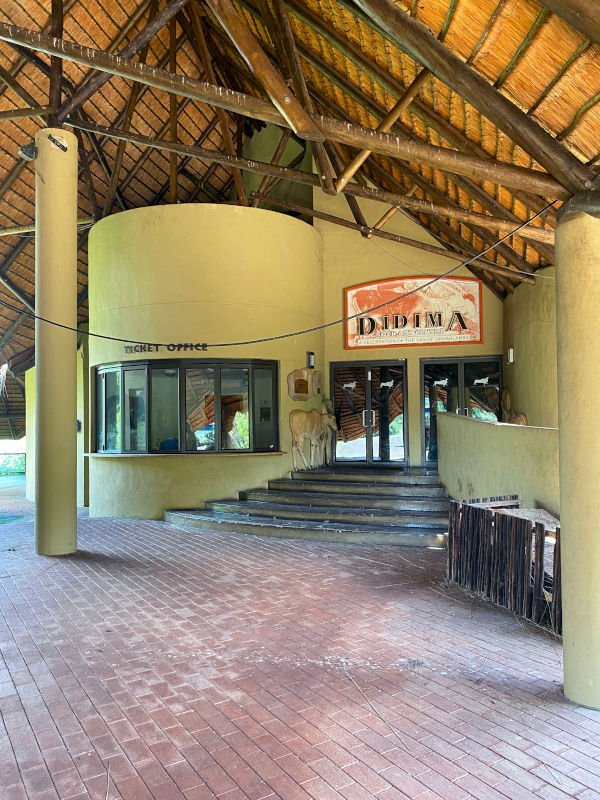
Three COSMO-ART team members took part in the international conference « Southern African Mountains – Overcoming Boundaries and Barriers« , held at the Champagne Sports Resort. Focused on issues related to mountain territories in Southern Africa, the conference was structured into 26 parallel sessions.
As part of the « Mountain People’s Livelihoods » session, Mélanie Duval, Hugo Quemin, and Antoine Latarge presented research conducted within the ANR COSMO-ART project, partly linked to the GéoExTour project, supported by Labex ITTEM.
During this session, several presentations also addressed governance challenges in mountain territories, questioning the involvement of different stakeholders, particularly in projects with conflict dimensions (e.g., mining activities, large-scale infrastructure projects). Valuable contacts were established with researchers working on similar topics and study areas, closely related to the COSMO-ART research and the PhD project of Antoine Latarge, funded by Labex ITTEM.
The field excursion day provided an opportunity to revisit sites explored by Mélanie Duval between 2009-2019 (Didima Rock Art Centre). This visit allowed for an update on data regarding rock art tourism management in the Drakensberg area, and more particularly in the Didima Valley.
Photovoice exhibition
- Johannesburg, South Africa
- 12 – 16 March 2025
- Leïla Baracchini, Mélanie Duval, Antoine Latarge, Lourenço Pinto & Hugo Quemin
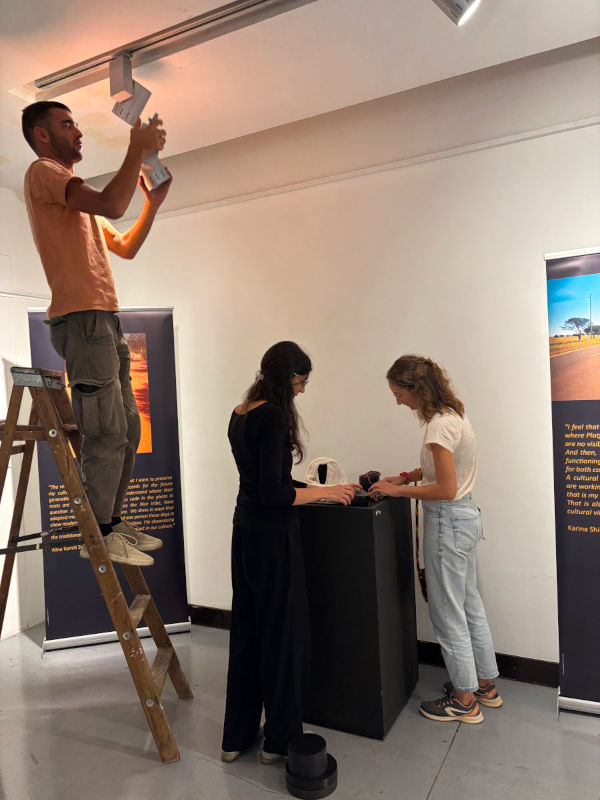
From March 12 to 16, several members of the COSMO-ART team actively participated in setting up the « Places in Me » exhibition at the Origins Centre and in organising various science and culture events surrounding the exhibition opening, in collaboration with the two San communities of Platfontein.
Presenting French rock art to the public
- Vézère Valley, France
- 28 October 2024 – 25 February 2025
- Curtis Jeaven
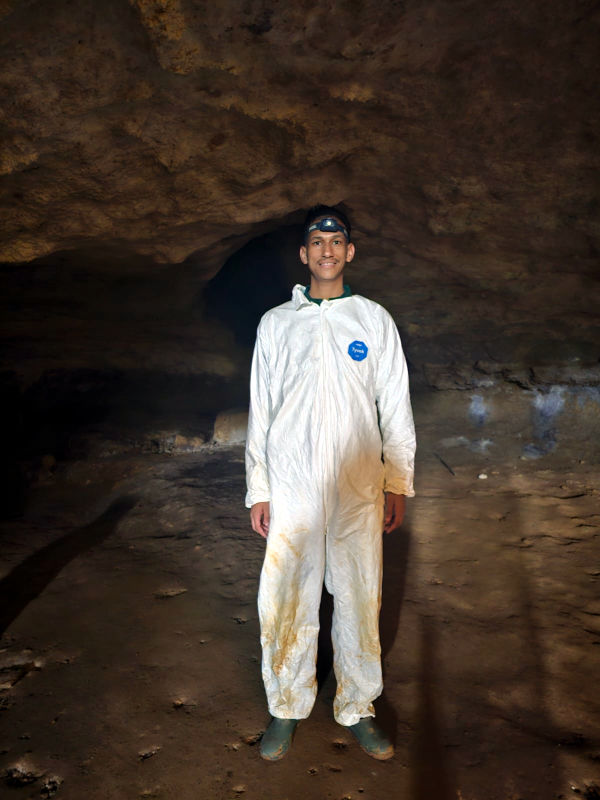

On 22 July 2024, I was honoured to receive a laureate award from the Embassy of France in South Africa, Lesotho, and Malawi. This prestigious cross-mobility scholarship funded four months of research in the Vézère Valley, France, allowing me to explore one of the world’s most significant ancient rock art regions.
Located in southwestern France, the Vézère Valley is home to approximately 147 ancient rock art sites, both publicly and privately owned. I had the privilege of visiting several of these sites, beginning with La Mouthe on 29 October 2024. Discovered in 1895 by Émile Rivière, La Mouthe played a crucial role in the early acceptance of ancient rock engravings in Europe.
Building on to the visit to La Mouthe, I had visited Font-de-Gaume, Les Combarelles, Cap Blanc Rock Art Shelter, Rouffignac Cave, Lascaux II and Lascaux IV. In addition, I had visited the Prehistory Interpretation Center and the National Museum of Prehistory. These visits were from November 2024 – February 2025 on multiple occasions. During the visits, I conducted observations and interviewed tour guides in the regions to analyse to what extent rock art is presented in the Vézère Valley.
Apart from the observations and interviews, there were two noteworthy events which is fundamental to my study. The first was attending the esteemed ‘Presenting Rock Art Sites’ RAHMSA workshop in the Vézère Valley from the 27th of November to the 3rd of December 2024. This workshop was intellectually rewarding as it links directly to my master’s research topic. The second was presenting my research titled: “Rock art presentation: A comparative analysis between the uKhahlamba Drakensberg Park, South Africa and the Vézère Valley, France” at the National Museum of Prehistory on the 13 February 2025.
Following the mobility period in France, I will do mobility research in the uKhahlamba Drakensberg Park, South Africa, from March to April 2025.
Internship at the Musée national de Préhistoire
- Les Eyzies, France
- 3 – 11 December 2024
- Kaarina Efraim & Lenishwa Engelbrecht

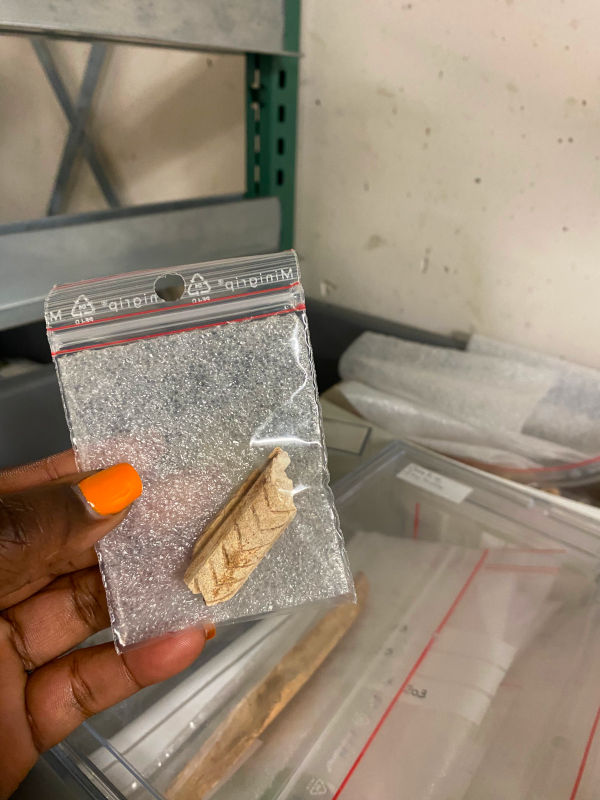
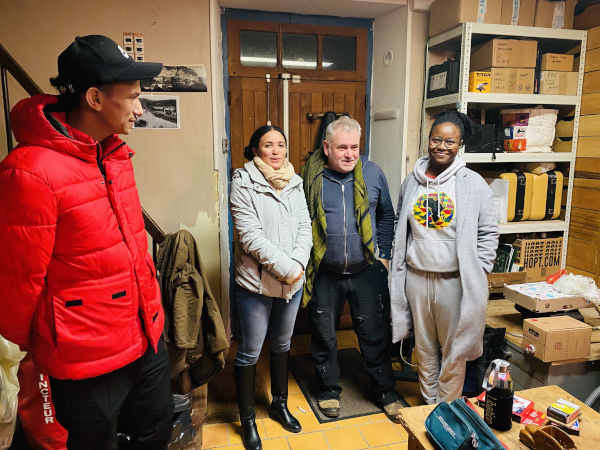
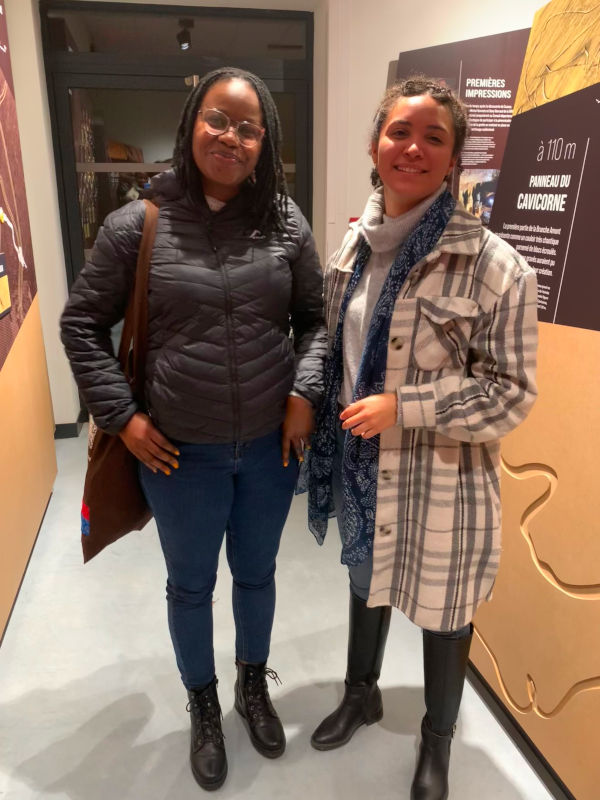
Following their participation in the IRN RAHMSA workshop, « Presenting Rock Art Sites« , Kaarina and Lenishwa spent a week at the Musée National de Préhistoire (Les Eyzies, France). This short stay provided an opportunity to share experiences with other museum curators and heritage officers, engage with curatorial practices, the management of archaeological resources, and the organisation of rescue archaeology as practised in France, and reflect on the broader implications for their respective work in Namibia.
The visit also revealed numerous opportunities for collaboration. Knowledge exchange, joint research projects, training programs, and capacity building could serve as mutually beneficial pathways.
Survey and spatial analysis of rock art in the Erongo Mountains
- Erongo Mountains, Namibia
- 17 – 29 July 2024
- Stéphane Hœrlé, Julien Monney & Lourenço Pinto
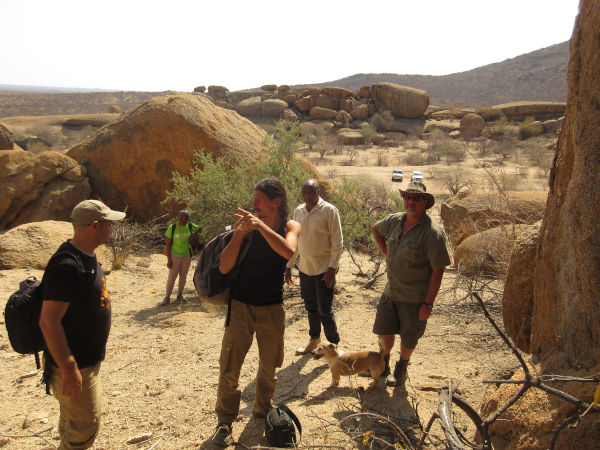
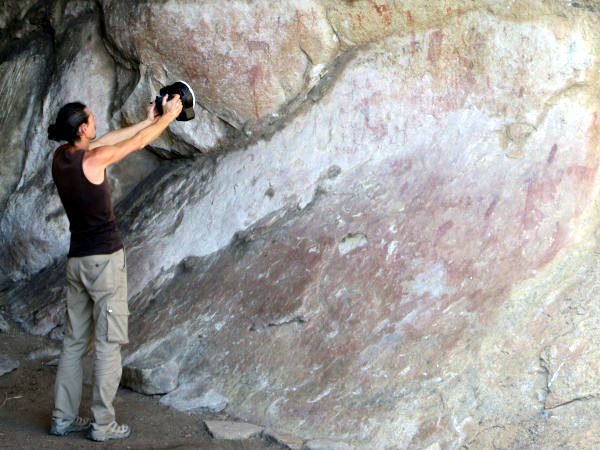
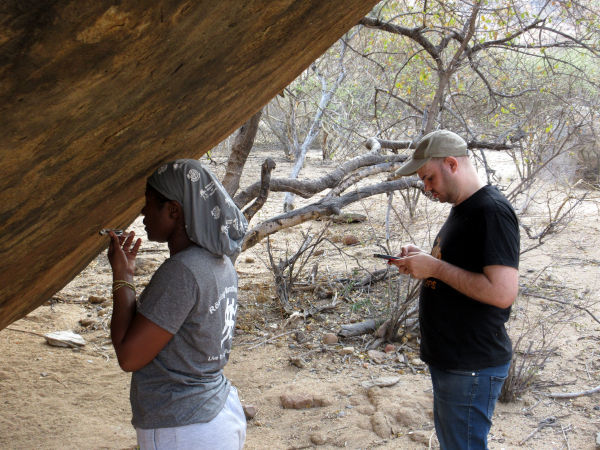
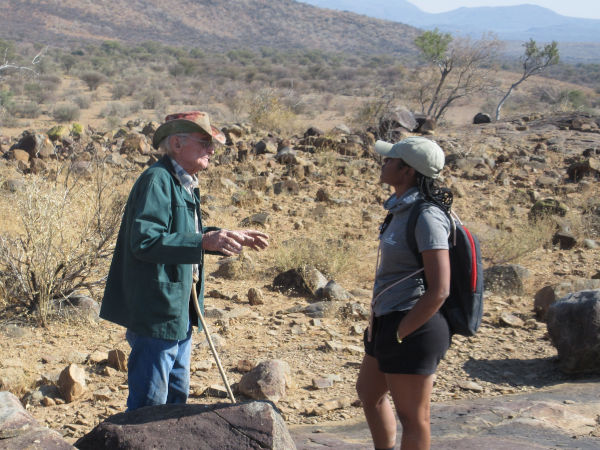
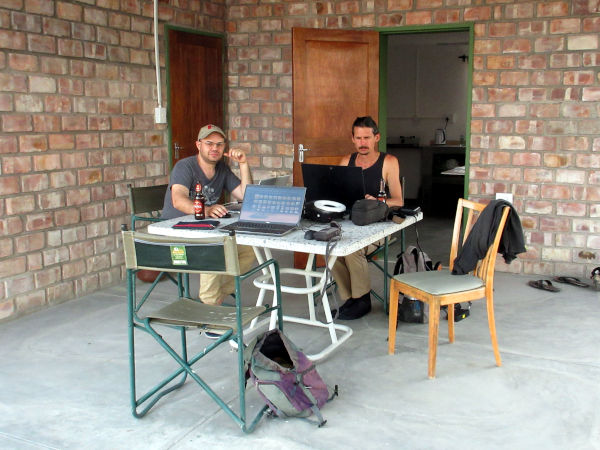
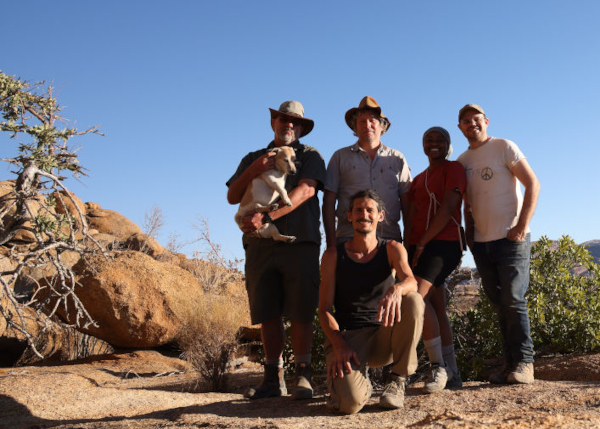
The aim of the fieldwork was to complete the available data on the distribution of rock art sites in an area of particular interest in the Erongo Mountains, in order to carry out a spatial analysis and test hypotheses on the distribution of rock art sites in the interface zone between the massif and the surrounding plains.
More specifically, the practical objectives of this fieldwork session were to
- complete the existing inventory of rock art sites in several areas of interest on the Omandumba West farm, in order to get closer to a complete inventory;
- evaluate the quality of the inventories already carried out in neighbouring areas on the edge of the massif (in particular the Anibib and Etemba farms and the communal areas around the villages of Khomxas and Tubusis);
- assess the potential of other areas of the massif with a view to possible expansion of the project;
- meet the owners or managers of the farms mentioned or make new contacts.
The fieldwork was highly successful, with many sites documented and accurately mapped, including a significant number that, to our knowledge, did not appear in any pre-existing inventory. Particular attention was paid to completing the inventory of rock art sites on the Omandumba West farm and to approaching completeness in several areas of interest, which is a prerequisite for spatial analysis of the distribution of sites in the landscape. It also made it possible to assess the possibility of extending the surveys to other areas of the massif or its fringes in future campaigns, and to establish the necessary contacts for this purpose. These new data have been added to the project’s Geographic Information System (GIS), which already contains previous inventories and data from the literature.
During this fieldwork, the COSMO-ART team had the pleasure of being accompanied by Mirjam Amunime from the National Museum of Namibia.
Special thanks to the people who made this fieldwork possible: Helga and Karl Hinterholzer (Ekuta farm), Gabriel Naobeb (Tubusis), Deike and Harald Rust (Omandumba West), Martin Steppe (Etemba farm), and Immanuel Vatileni (Ai Aiba Lodge / Anibib farm).
Co-creating with communities: preparing the 2025 RAHMSA workshop
- Platfontein, South Africa
- 24 June – 1 July 2024
- Mélanie Duval, Lourenço Pinto & Hugo Quemin
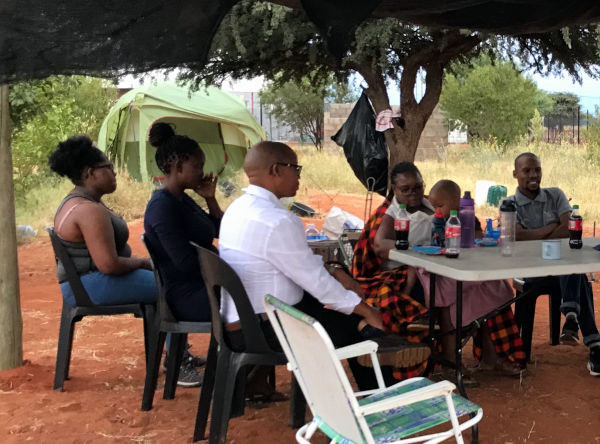

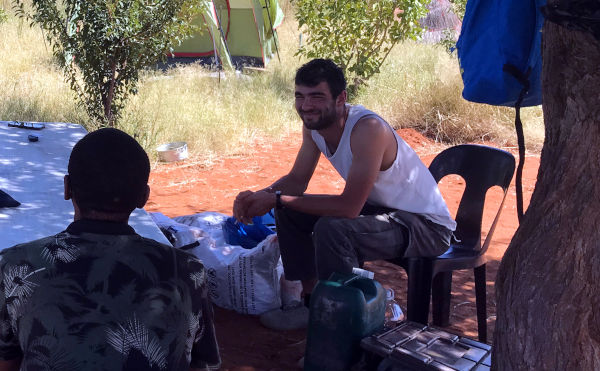
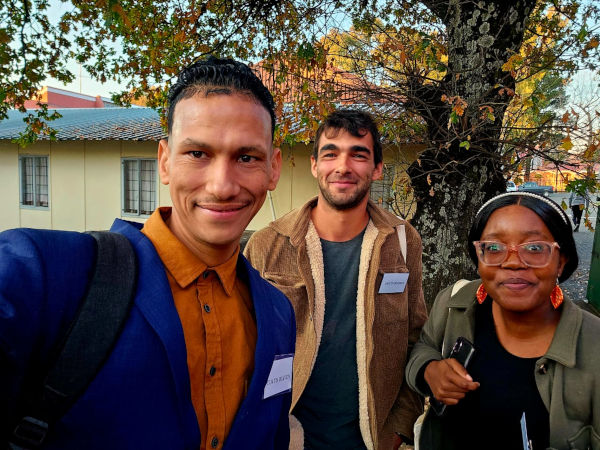
In connection with the COSMO-ART project and the series of workshops run by IRN RAHMSA, additional funding has been obtained under the 2024 CNRS Call « Science and/or society ». The project selected is entitled « Les enjeux associés à la mise en Tourisme Communautaire des Patrimoines Locaux: co-conduite d’ateliers participatifs en vue d’une co-construction des savoirs » (ToCoPaLoc). Its aim is to continue and strengthen the collaborative dynamics initiated with the two local NPOs in Platfontein (SANCD and SASDO), and colleagues from the University of Sol Plaatje.
From 24 June to 1 July 2024, participatory workshops with members of these two communities were organised around the following questions: to what extent can community-based tourism organised around the promotion of local heritage be sustainable? What forms could these tourism initiatives take? What are the socio-spatial implications of these forms of tourism? How can the issues of conservation and promotion of heritage elements be reconciled?
Discussions with the two NPOs and Sol Plaatje’s colleagues have enabled progress to be made on the effective organisation of a workshop to be held in March 2025, funded by IRN RAHMSA. The workshop, which will focus on community tourism and heritage issues, will be a 10-day itinerant tour of Limpopo Province. The main objectives of the workshop will be to enable members of the Khwe and !Xun communities to meet and exchange views with communities that are also involved in forms of heritage tourism. Discussions started at the end of June 2024 have enabled progress to be made on the selection of members of the two communities who will take part in the 2025 workshop and on the question of the languages to be used in this work.
During the week, a quick return trip to the international conference organised by ASAPA (Maseru, Lesotho) also provided an opportunity to present the work of the COSMO-ART project.
Geoheritage tourism in the Erongo Region (Brandberg and Erongo Mountains)
- Brandberg and Erongo Mountains, Namibia
- 1 – 14 May 2024
- Mélanie Duval, Kaarina Efraim, Marie Forget, Antoine Latarge & Hugo Quemin
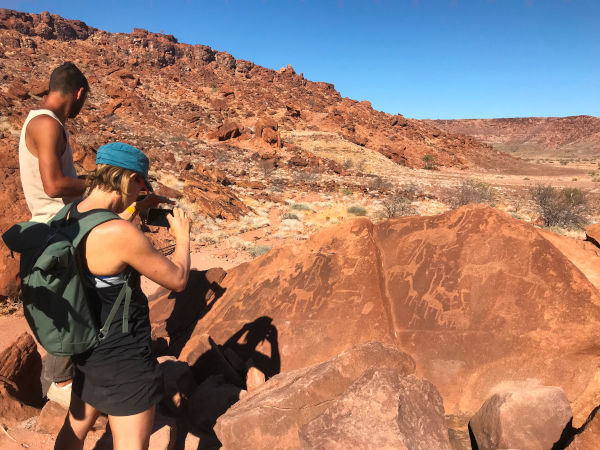
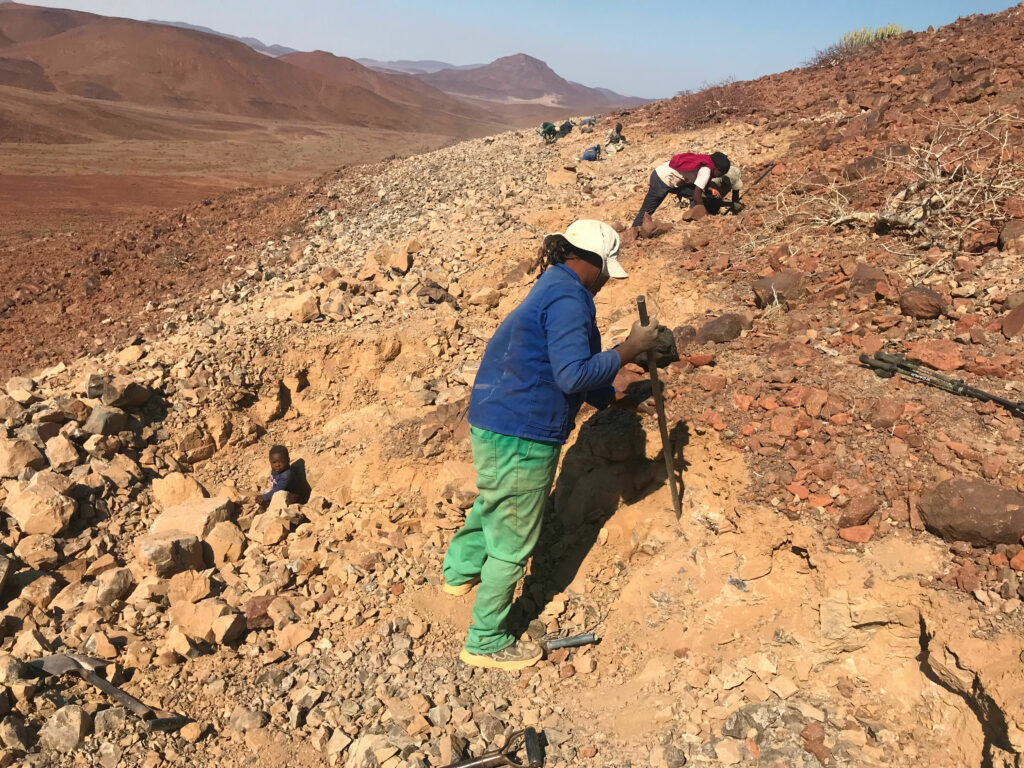
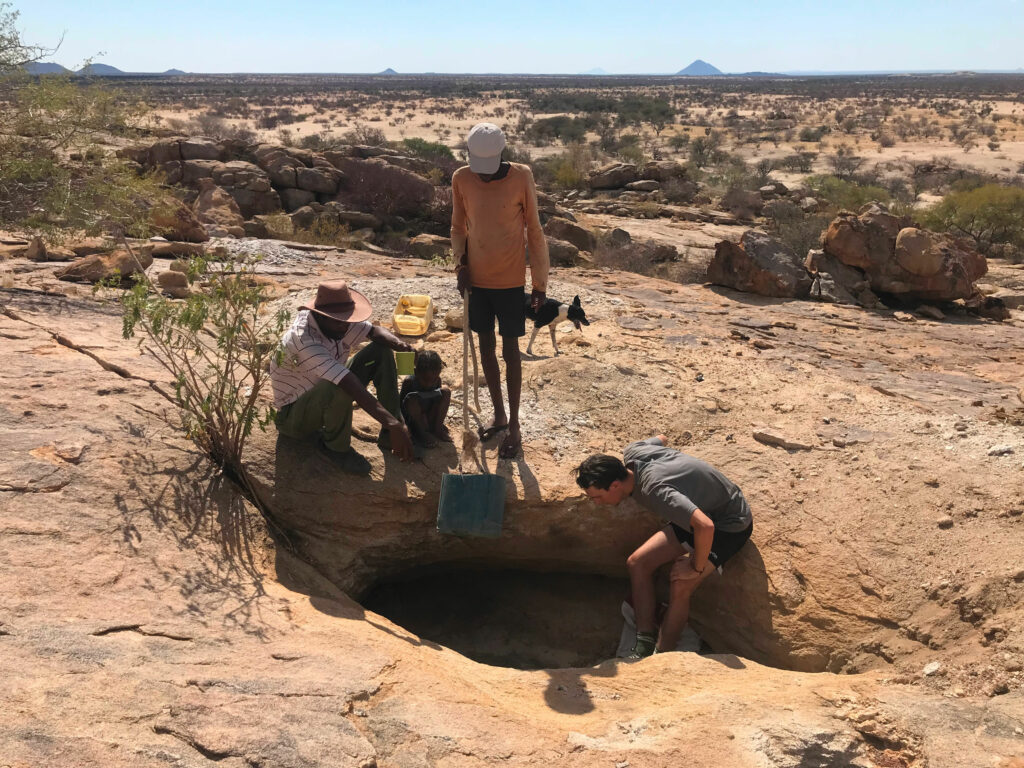
Over a period of two weeks, researchers and students from EDYTEM and the National Museum of Namibia analysed the issues relating to the creation of the Gondwana Geopark. The proposed geopark covers a large area that overlaps with protection and development zones for rock art sites, including the Erongo Mountains and Brandberg.
Using a critical approach, the aim was to put into perspective the official discourse produced about this Geopark and the actual knowledge of this project by the stakeholders and inhabitants of this large area. Therefore, during this field trip, the main geosites of the Geopark project were visited and interviews were conducted with the main stakeholders.
The field trip also allowed us to gain a better understanding of the problems caused by small-scale mining in these two massifs. Through a series of observations and interviews, it was possible to assess the extent to which this type of mining activity can be a threat to the protection and tourist development of the rock art sites in these two massifs.
COSMO-ART and the GéoExTour project (funded by Labex ITTEM) jointly supported this fieldwork
Involvement of local communities in the management of rock art sites
- Wildebeest Kuil (South Africa) & Sptizkoppe (Namibia)
- 4 April – 4 May 2024
- Shanty Fisher

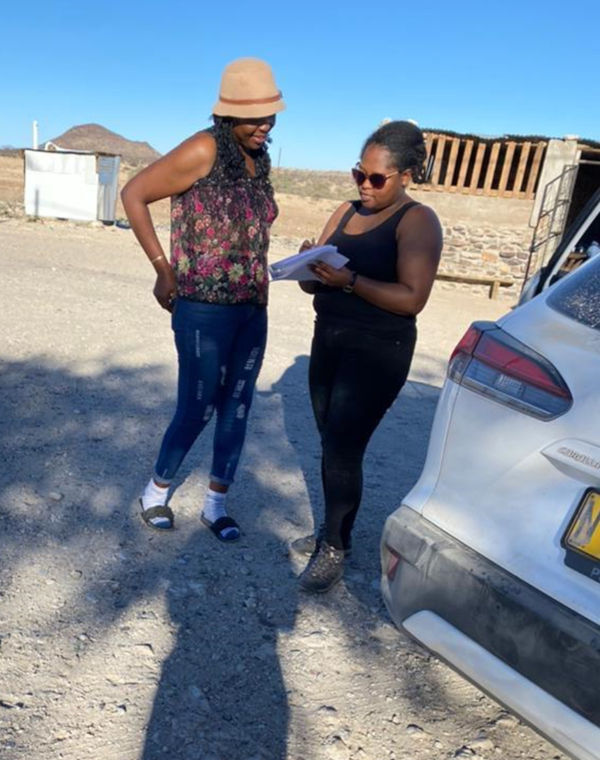
For the International Erasmus Mundus Master in Quaternary and Prehistory Shanty’s second-year research project was to investigate how local communities are involved in the management of rock art sites, and to assess the extent to which local communities are consulted and involved in the development of management plans and subsequent management and development of the sites. Shanty compared the Spitzkoppe massif in Namibia and Wildebeest Kuil in South Africa.
In Namibia (4-19 April), after documenting the rock art sites open to tourism, she interviewed (i) various key institutional stakeholders, (ii) local community guides who take visitors to the sites, and (iii) members of the local community.
In South Africa (21 April – 4 May), as the site had already been documented by researchers from the COSMO-ART team, Shanty’s work focused on interviews with members of the two Khwe and !Xun communities in Platfontein.
Putting these two case studies into perspective highlights a discrepancy between the desire of communities to be more involved in the management of rock art sites and the way in which institutions operate.
Rock art epistemology: archival research
- Kimberley, South Africa
- 13 – 26 March 2024
- Juliette Barthélemy
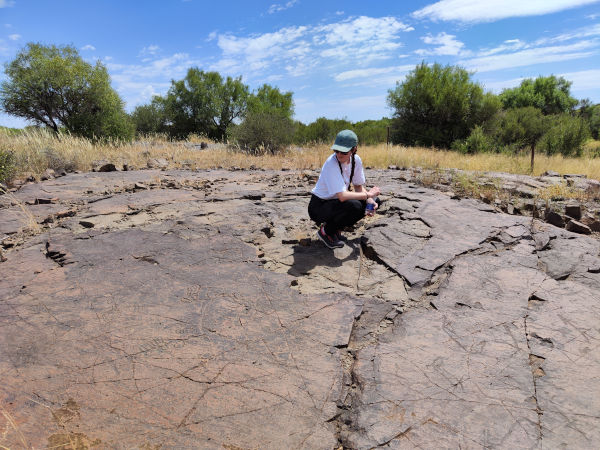
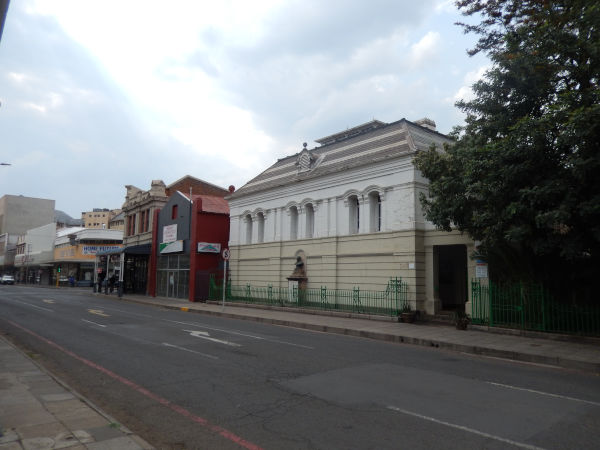
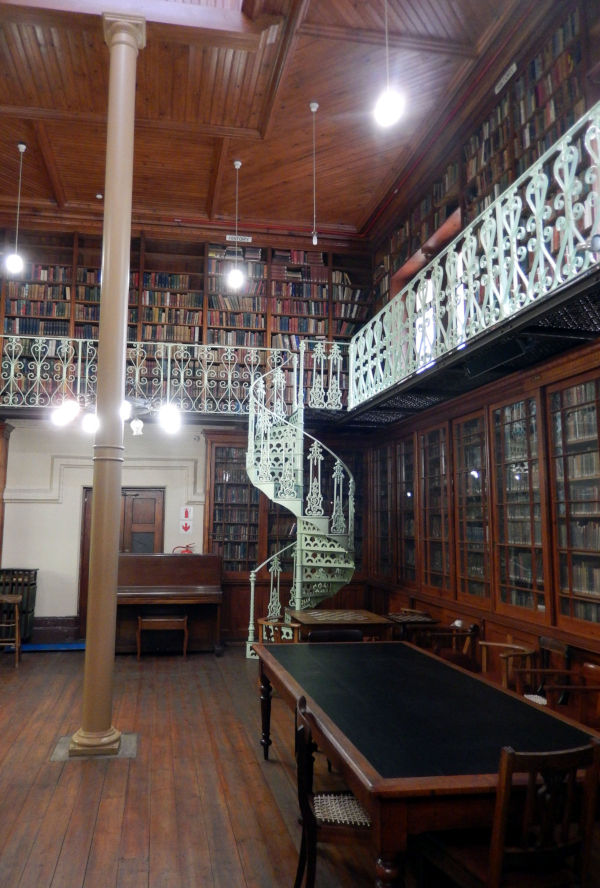
During my stay in South Africa, and more specifically in Kimberley, I was lucky enough to have access to several archive centres, the library of the Sol Plaatje Museum, the Africana Library, as well as the McGregor Museum, whose doors were very kindly opened to us thanks to researcher David Morris, who allowed us to visit almost every day. The McGregor Museum’s Archaeology Department has a large number of boxes in which a wide variety of documents (articles, reports, surveys, photographs, correspondence) have been carefully stored and numbered, especially the annals of several museums (the McGregor, the South African Museum, the former Transvaal Museum, the William Humphreys Art Gallery), scientific papers, other publications and old issues of journals of South African archaeological institutions (World Archaeology, South African Archaeological Bulletin, Digging Stick, South African Historical Journal, etc.).
I spent most of my time between the archives of the Archaeology Department and the museum library, in order to record new data and unpublished articles on rock art in Southern Africa.
Finally, I was able to visit 3 rock art sites in the Karoo region (geologically speaking), Wildebeest Kuil, Nooigtedacht and Driekopseiland, visits which helped us to understand the physical, tourist and even political reality of the sites in question.
Co-creating with communities
- Johannesburg & Platfontein, South Africa
- 10 – 27 March 2024
- Mélanie Duval, Stéphane Hœrlé & Hugo Quemin
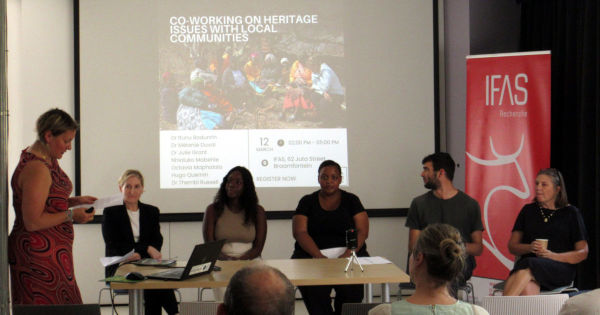
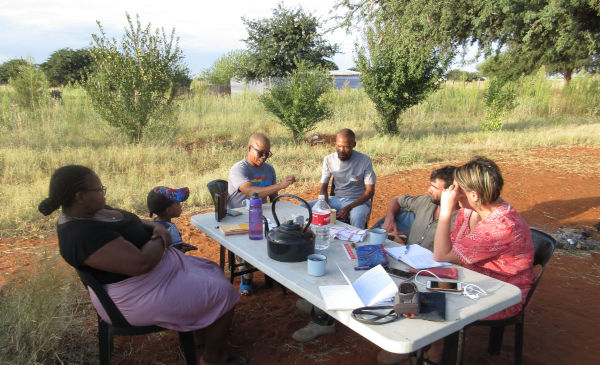

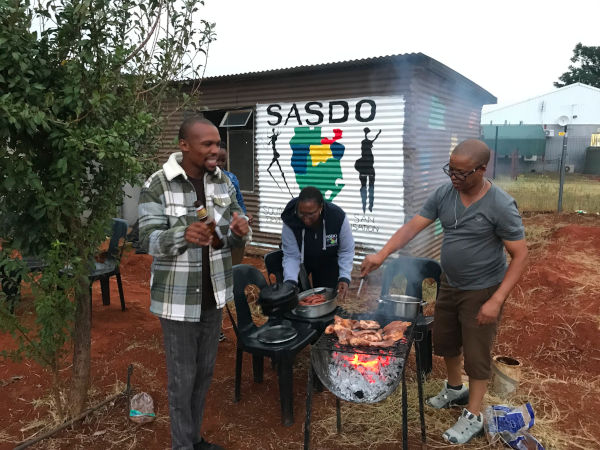
This fieldwork session had several objectives:
- a seminar at IFAS Recherche on modes of co-creation between local communities in sub-Saharan Africa and researchers;
- feedback to the ǃXun and Khwe communities of Platfontein on the heritage workshop held on 5 July 2023;
- co-creation with the same two communities of two projects to be implemented in March 2025, namely the installation of the « Places in me » exhibition at the Origins Centre (Johannesburg) and a RAHMSA workshop entitled « Towards a sustainable community heritage tourism » and planned for 2026;
- collecting of qualitative data on social and political organisational issues in both communities;
- visits to rock art sites around Kimberley to observe the dynamics of the re-qualification of the Wildebeest Kuil Interpretation Centre and to analyse the forms of tourism development at Nooitgedacht and Driekopseiland.
Joint fieldwork: geomorphology, archaeology, photovoice exhibition, and heritage issues
- Kimberley, South Africa
- 25 June – 8 July 2023
- Leïla Baracchini, Lucas Bruchet, Laurent Bruxelles, Sophie Dulucq, Mélanie Duval, Shanty Fisher, Abenicia Henderson, Stéphane Hœrlé, Curtis Jeaven, Julien Monney, David Morris, Lourenço Pinto, Hugo Quemin
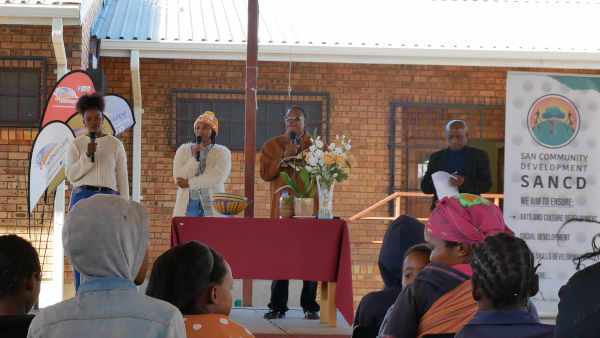
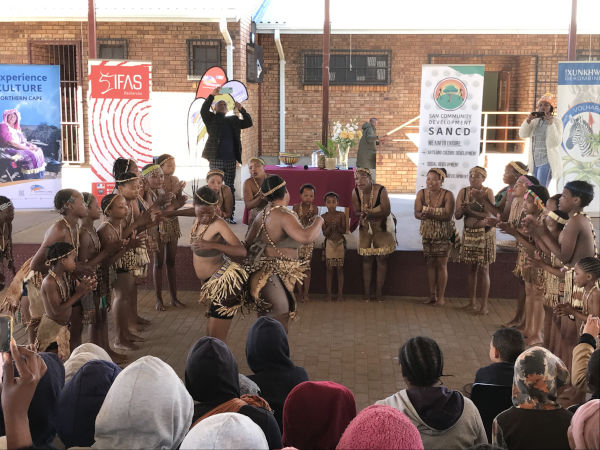

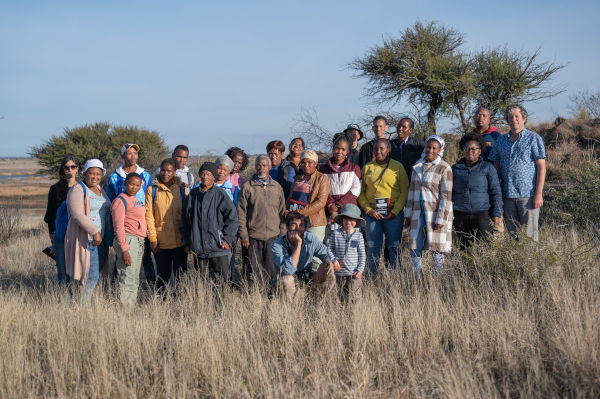
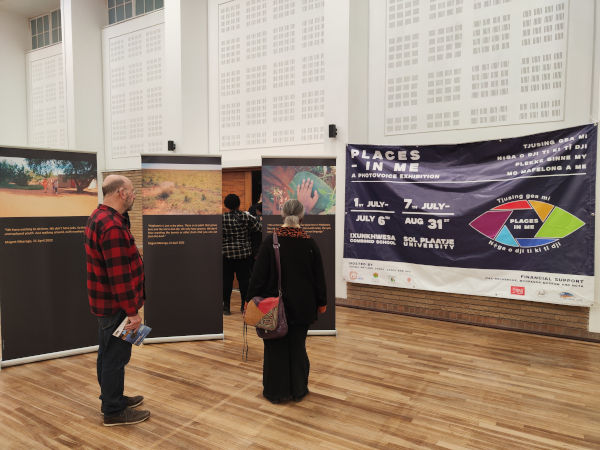
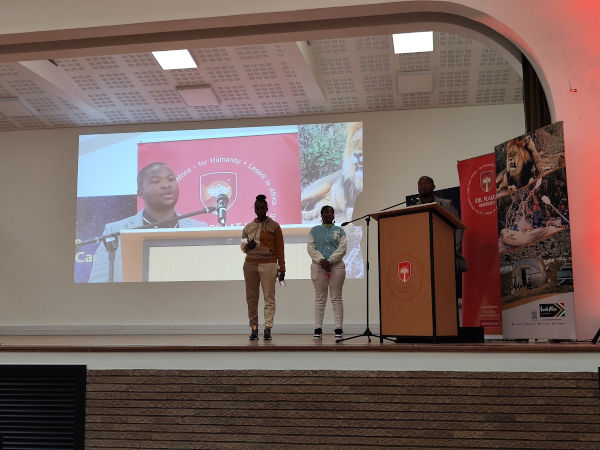
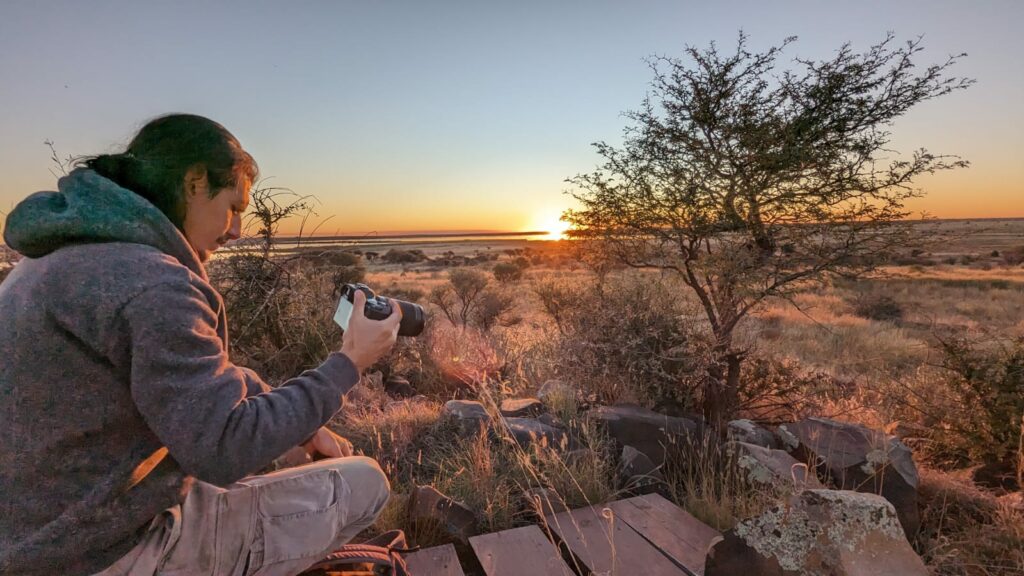
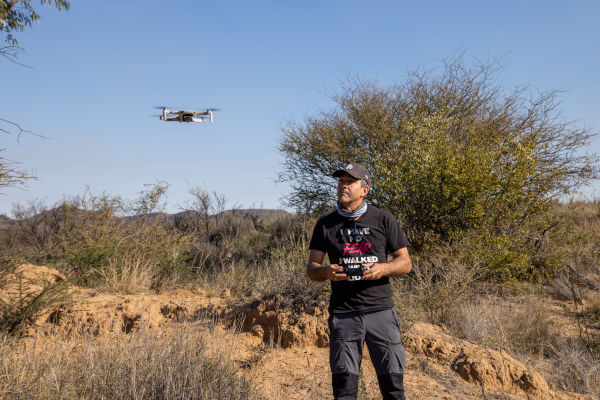
For two weeks, 12 researchers involved in the COSMO-ART project worked together on two topics: 1/ finalising the « Places in Me » exhibition; 2/ analysing the man-made structures at Wildebeest Kuil.
Topic 1: « Places in Me »
The exhibition is the result of research co-constructed during Leïla Baracchini’s post-doc with young people from the Khwe and !Xun communities in Platfontein. These two communities live close to Wildebeest Kuil and one of the goals of the COSMO-ART project is to question their relationship with this site. To this end, a photovoice protocol has been set up. In practical terms, the project participants were equipped with cameras. To address the issue of heritage, they took photos of what was important to them in their environment. The photographers were then interviewed about their photos to understand why they took them and what they wanted to express. Excerpts from the interviews were then selected for the exhibition and displayed alongside the photographs. The exhibition is therefore made up of the images and words of the young people of Platfontein, providing an insight into what their heritage is from their own point of view. The exhibition is called « Places in me » and was produced with the financial and logistical support of IFAS-Recherche, the McGregor Museum, NCTA and PanSALB. The aim of this field trip was to work with the SANCD, SASDO and SPU partners to finalise the exhibition, with two openings, the first in Platfontein,at Xunkhewsa combined school, and the second at Sol Plaatje University. A workshop on heritage was also organised with the Khwe and !Xun communities of Platfontein. With the support of NCTA, buses were used to transport participants to Wildebeest Kuil. At the site, after discussions with the research team, focus groups were held to gather their views on heritage and this rock art site in particular.
Topic 2: Analysis of man-made structures at Wildebeest Kuil
This part of the field trip, which involved archaeologists and geomorphologists, began with a reconnaissance of Driekopseiland, Nooitgedacht and Wildebeest Kuil (the three sites in the region studied by the COSMO-ART project) to determine which offered the greatest potential for establishing a chronology of human activity through the study of above-ground man-made stone structures. In the end, Wildebeest Kuil was selected. The distribution of rock art was then mapped across the site. The team then identified and mapped the man-made stone structures in order to combine the two in a spatial analysis of the relationships between rock art and stone structures. All these elements made it possible to establish a relative chronology of all human interventions on the site, from the first engravings to the most recent Kraal-type developments. The chronological indicators were essentially the study of patinas and boulder shapes, which may or may not reflect reworking by man or by natural elements. Ultimately, these observations will be compared with the typology of engravings established during the April 2022 fieldwork. Links are already emerging between the nature of the rocks and the distribution of the engravings.
Heritage values and constructed issues
- Erongo Mountains, Spitzkoppe & Tsumkwe, Namibia
- 21 March – 4 Mai 2023
- Hugo Quemin
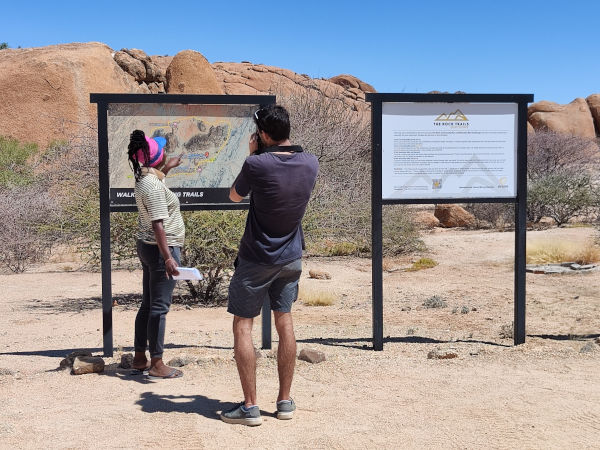
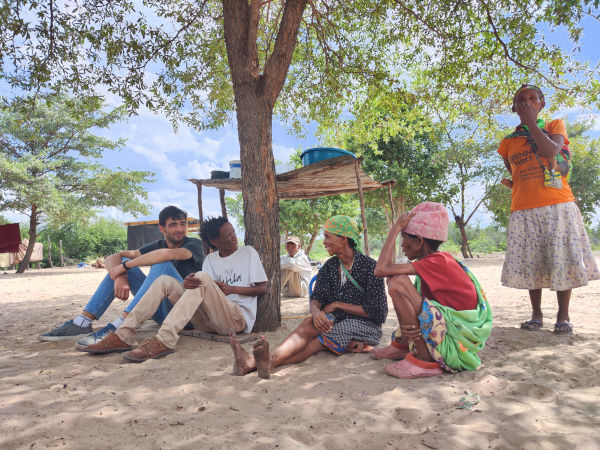
In the course of this collective mission, I first wanted to look at the connections between small-scale mining activities and policies for the preservation and promotion of rock art sites in the Erongo Mountains and at Spitzkoppe.
For this purpose, a global overview of the issues at stake in the rock art sites had to be carried out in order to situate my interests in the perspective of the current issues in these areas. For this purpose, interviews were conducted with various actors (institutions, farmers, guides, archaeologists…) and were complemented by informal discussions (inhabitants of Spitzkoppe and the Okombahe community). A particular focus on the discourses of the actors and the way they mobilise rock art heritage allowed me to focus on a related issue: the way rock art sites are mobilised for specific purposes beyond the sole purpose of preservation.
Later, I was also able to spend four days in the national archives in Windhoek, a time that allowed me to acquire important information, such as the history of rock art site preservation in Namibia.
Finally, this time in Namibia allowed me to further develop my PhD project by completing the initial overview from October 2022, answering some previously established questions and extending my focus to a more specific analysis of the differentiated interests of actors towards rock art and the selective and exclusionary processes surrounding their preservation issues.
San cultural village – which tourism?
- Tsumkwe, Namibia
- 8 – 12 April 2023
- Mélanie Duval, Kaarina Efraim & Hugo Quemin

The field studies carried out in the Erongo Mountains highlighted the involvement of San communities from the Tsumkwe region, some 700 km to the north-east. Understanding the involvement of the San in the heritage and tourism dynamics of the Erongo Mountains meant visiting the conservancies of Nyae Nyae and N#a-Jaqna. Within the two conservancies, field observations and interviews with various resource people enabled us to meet the villages involved in exchanges with the Erongo Mountains, and to understand this organisation in relation to the two other San cultural villages in the area, namely The Living Museum of the Ju/’Hoansi-San (Grashoek) and The « Living Hunter’s Museum » of the Ju/’Hoansi-San (Tsumkwe).
Joint fieldwork: 3D models – GIS – analysis of heritage issues
- Erongo Mountains & Spitzkoppe, Namibia
- 26 March – 7 April 2023
- Nadia Belaïdi, Benoît Caron, Mélanie Duval, Kaarina Efraim, Marie Forget, Stéphane Hœrlé, Stéphane Jaillet, Julien Monney, Alma Nankela, David Pleurdeau & Hugo Quemin
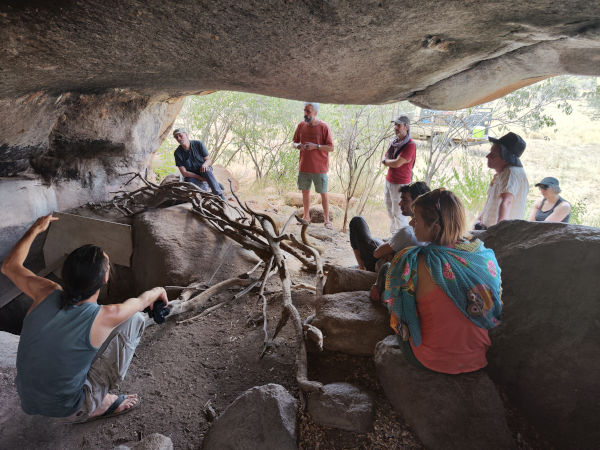
Over a period of ten days, 11 researchers involved in the COSMO-ART project met in the Erongo Mountains. The work was organised around three main themes:
- Geomophology: 3D surveys and drone photography of rock shelters excavated by colleagues, with the aim of improving our understanding of the dynamics of landscape formation and constructing a relative chronology of site occupation and the production of rock art.
- Spatial analysis: definition of a working protocol for the creation of a database of rock art sites on the massif. During this week, research focused on the sites located on the Omandumba West farm. Combining phases of data entry and systematic inventory within the boundaries of the farm, these activities also enabled the taking of photographs that will be used for the the photographic exhibition to be held in Windhoek in September 2023.
- Analysis of heritage dynamics: observation and analysis of the ways in which rock art sites are protected and promoted as tourist attractions; several semi-directive interviews with different types of stakeholders involved in the preservation and promotion of rock art sites in the Erongo Mountains and the Spitzkoppe massif; contextualisation of these heritage issues in relation to mining issues.
In terms of multidisciplinary work, the decision to be in the field at the same time, stay in the same place and eat together enabled all the teams to share their practices with each other, thereby encouraging cross-disciplinary work. In addition, the more formal working sessions provided an opportunity to discuss the nature of the results obtained by the different teams and to begin to make links between these different approaches, with a view to proposing a holistic approach to the issues associated with the conservation and enhancement of rock art sites in the Erongo Mountains.
Workshop and exhibition projects – Mining issues
- Windhoek, Namibia
- 21 March – 25 April 2023
- Mélanie Duval, Marie Forget, Stéphane Hœrlé & Hugo Quemin
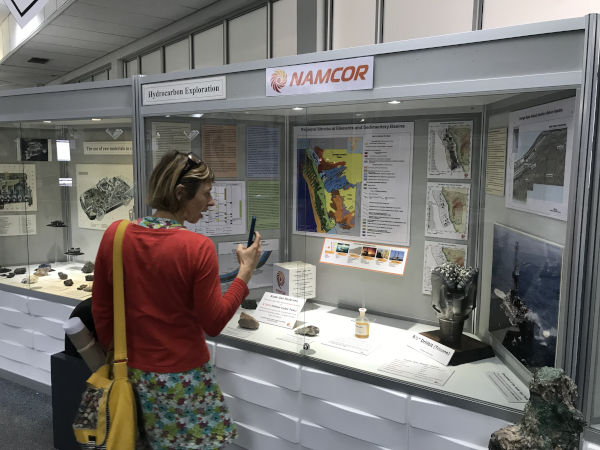
For one week, several COSMO-ART researchers met in Windhoek to work on:
- Programmatic: the team has made progress in organising of a workshop in Namibia in September 2023 on the documentation issues associated with rock art sites. To this end, the first outlines of this forthcoming scientific event were drawn up with the UNAM partners. Several meetings also allowed progress to be made on the photographic exhibition project, which will take place at the Franco-Namibian Cultural Centre in September 2023. As part of National Heritage Week (18-22 September 2023), this photographic exhibition entitled « Heritage and Culture: a rock-solid foundation – A tribute to rock art in Namibia » will showcase several rock art sites in the Erongo Mountains, a massif invested in as part of the ANR COSMO-ART project. The week in Windhoek brought together several partners: the FNCC, the COSMO-ART team, the Museums Association of Namibia, National Museum of Namibia, and the National Heritage Council. The meetings enabled progress to be made on the content of the exhibition and associated events.
- Research: in order to contextualise the issues surrounding the protection and development of rock art sites in relation to mining issues in Namibia, interviews were conducted with various departments within the Ministry of Mines and Energy, the Ministry of Environment, Forestry and Tourism and the National Heritage Council. These interviews enabled us to understand the differences between large-scale mining and small-scale mining in terms of the nature of operations, the granting of permits and the way in which local communities are involved. In turn, these contextual elements provided a better understanding of the issues surrounding the protection and development of rock art sites in the Erongo Mountains, as this massif is characterised by the presence of several areas of small-scale mining.
Conservation of the paintings in Wonderwerk Cave
- Kimberley & Daniëlskuil, South Africa
- 15 February – 22 April 2023
- Anaïs Empereur-Buisson & Stéphane Hœrlé
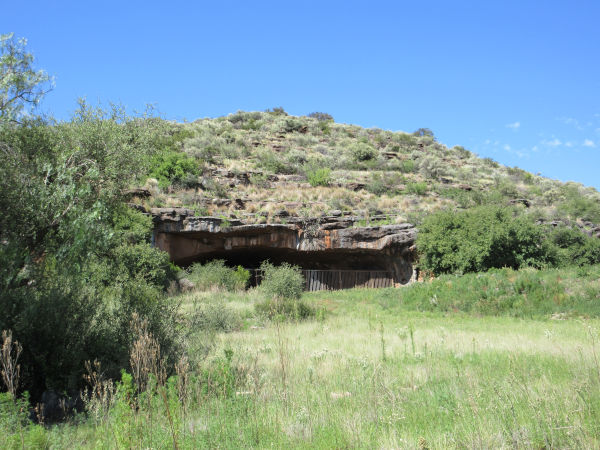
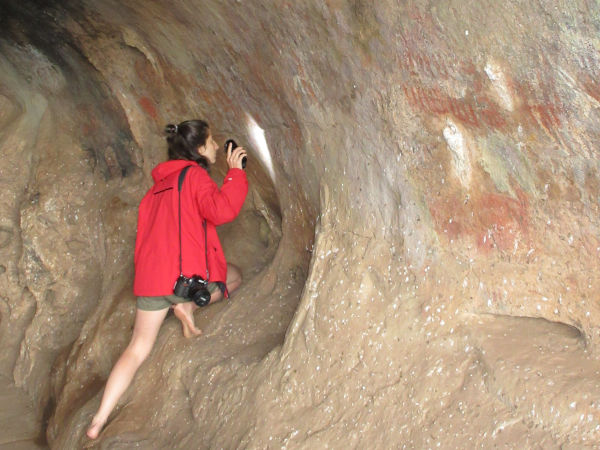
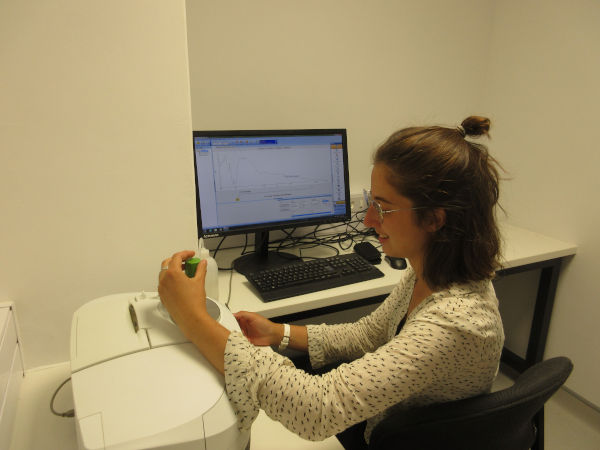
Anaïs stayed about nine weeks in South Africa to carry out her research project on the conservation of the paintings in Wonderwerk Cave to obtain her Master’s degree in Archaeology at the University of Bordeaux. During her stay she was hosted by Sol Plaatje University and accompanied by her supervisor, Stéphane Hœrlé, for most of her stay.
Her first two weeks were spent in Kimberley to search paper and photographic archives kept at the McGregor Museum and its satellite, the Duggan-Cronin Gallery. She also took advantage of this time in Kimberley to meet and interview people who could provide her with insights into the history of the cave, the conversation interventions that took place there and the management and operation of this public site.
Anaïs and Stéphane then moved to a place near Daniëlskuil, close to the cave, so that Anaïs could start her fieldwork. She identified the factors affecting the conservation of the paintings and monitored several of them, selected test areas where she focused her recording of the paintings, their alterations and previous conservation intervention. She also collected some samples of deposits and alteration products that she analysed in the Archaeology Laboratory at Sol Plaatje University.
Photovoice
- Kimberley, South Africa
- 21 January – 14 February 2023
- Leïla Baracchini
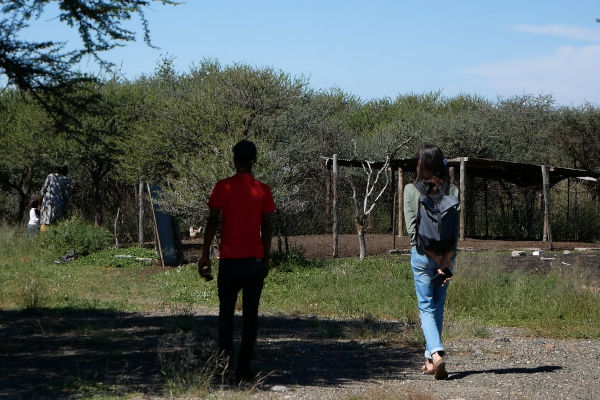
For this third fieldwork linked to the realisation of her post-doc, Leïla’s first objective was to meet all the participants in the photovoice project, 18 members from the two communities. Indeed, since her fieldwork in August, Leïla has been working on transcribing the interviews with the authors of the photographs, as well as on selecting extracts to place alongside the photographs in the upcoming exhibition. The main motivation for this third and final field trip was to validate the photographs and texts selected for the exhibition by the project participants.
These weeks in the field were also used to meet with the different partners of the project, namely two local NPOs (SANCD and SASDO) and members of the Sol Plaatje University and the McGregor Museum. With six months to go before the opening, there is still a lot to organise between the different partners to make this exhibition a success!
Heritage values and constructed issues
- Erongo Mountains, Namibia
- 3 – 13 October 2022
- Hugo Quemin
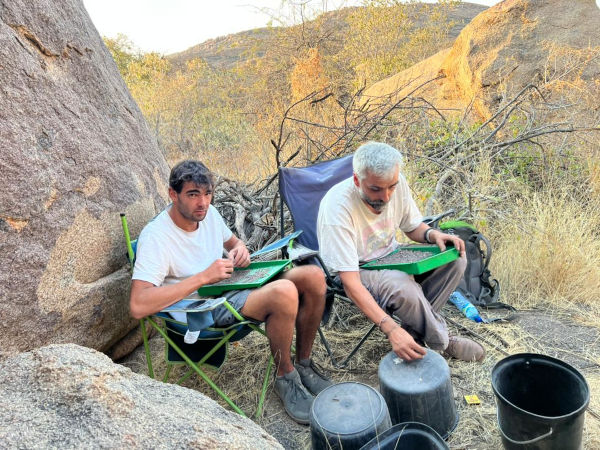
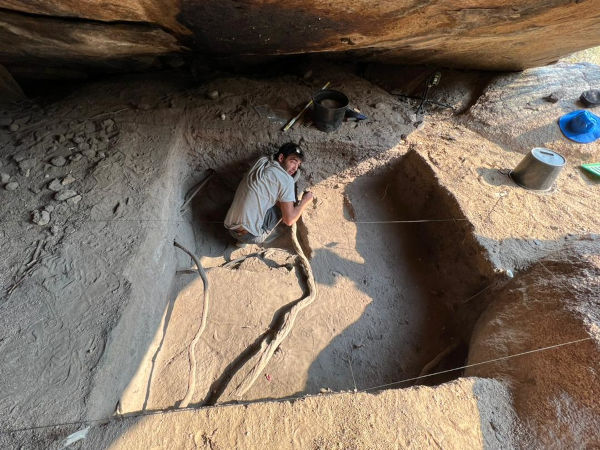
Hugo spent ten days participating in an archaeological excavation on Omandumba West Farm in the Erongo Mountains (Namibia), as part of a team led by David Pleurdeau (MNHM). During this time, he 1) learned the practical aspects of archaeological excavation at Seal Rock Shelter; 2) met with some of the actors and partners working on this field or in southern Africa; 3) visited various rock art and archaeological sites with his team; 4) prepared his return to Namibia between March and May 2023 by meeting with various institutions in Windhoek and referencing the documentation available locally.
Conservation
- Kimberley, South Africa
- 12 September – 26 October 2022
- Stéphane Hœrlé
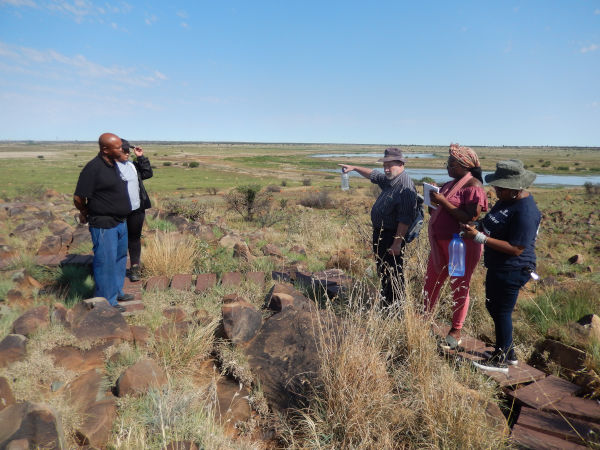
The trip to South Africa focused on the preparation of the research subject at Wonderwerk for an upcoming Masters student from the University of Bordeaux and the identification equipment available at Sol Plaatje University to be used by the student as well as for further studies of processes affecting rock art conservation. The potential for conservation studies at several rock art site previously screened for research within COSMO-ART (Driekopseiland, Nooitgedacht and Wonderwerk) was also evaluated. Finally, the preparation of an exhibition drawing on Leïla Baracchini’s post-doctoral work on participative photography was carried on with partners at the McGregor Museum, Platfontein (SANCD and SASDO) and the Sol Plaatje University.
Photovoice
- Kimberley, South Africa
- 1 August – 3 September 2022
- Leïla Baracchini
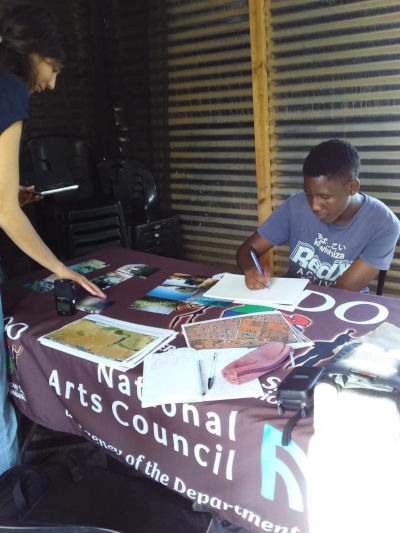
The five weeks spent in the field in Kimberley gave rise to a second photovoice session with nine participants, men and women, aged between 19 and 30, from the !Xun and Khwe communities of Platfontein. This photovoice session started with a workshop on the theme: « What is heritage for me? » The aim of this workshop was to get the participants to explore the ideas that come up spontaneously when talking about heritage and to bring out the concerns/interests that they themselves relate to the heritage issue (and therefore also what is excluded from it). The participants were asked to generate terms/ideas that the concept of heritage evoked for them, and then to discuss these terms in groups to try to define them and how they relate to heritage. They were then invited to discuss several proposals related to the concept of heritage. This workshop was also an opportunity to: review the aims and progress of the study, present the progress of the exhibition project, have the new participants read and sign the consent forms, distribute disposable cameras or memory cards (as desired). The 54 photographs from this workshop were then used in a series of individual interviews with each of the participants.
In addition, in order to gain a broader understanding of the interests and issues surrounding the presence of a rock art site in the vicinity (Wildebeest Kuil), several individual interviews were conducted with political representatives of Platfontein as well as with elders who had been involved with the Wildebeest Kuil site (as artists, storytellers or craftsmen).
Several discussions regarding the planning of the exhibition and its technical components also took place with the two NPO partners of the project, SANCD and SASDO, with the McGregor Museum and with the Department of Heritage Studies of the University of Sol Plaatje, which plans to offer Honoured students the opportunity to follow the exhibition process.
GIS
- Kimberley, South Africa
- 5 – 29 April 2022
- Julien Monney

With the aim of advancing the spatial analysis of Wildebeest Kuil, Julien Monney carried out an initial three-week fieldwork session. These were devoted to setting up a GIS (in an open format) capable of consolidating and analysing the spatial data produced by COSMO-ART. This required
- meetings with the human and social science researchers involved in the project to identify their needs for spatial data and to discuss the modalities of recording the values and practices associated with the sites;
- an inventory of existing spatial data at regional level;
- a literature review of the rock engravings at Wildebeest Kuil;
- a preliminary spatial recording of the rock engravings at Wildebeest Kuil;
- preliminary archaeological and geomorphological observations at the Wildebeest Kuil site in order to assess in detail the procedures to be implemented during the survey phase in June-July 2023.
Photovoice
- Kimberley, South Africa
- 15 March – 29 April 2022
- Leïla Baracchini
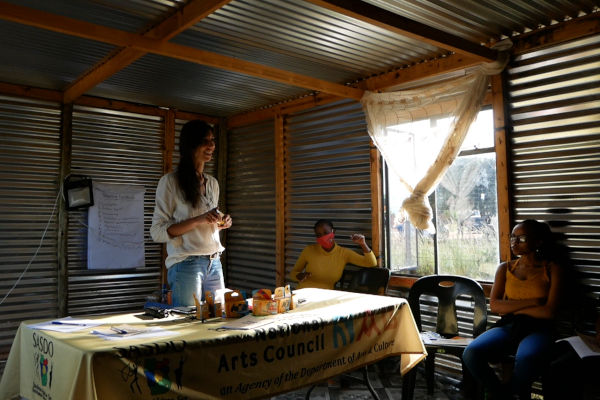
Still in the early stages of her post-doctoral studies in social anthropology, Leïla spent seven weeks in Kimberley, working on
- Meeting with the various partners: 1) Institutional partners: David Morris (McGregor Museum), Lourenço Pinto (Sol Plaatje University); 2) Local organisations (NGO, NPO, radio stations): SANCD, SASDO, X-K FM; 3) Translators: !Xun and Khwe; 4) Cultural institutions: !Khwa ttu.
- Team visits to the main rock art and archaeological sites in the region (Wildebeest Kuil, Canteen Kopje), as well as several tourist sites.
- Documentation at the Africana Library and the Sol Plaatje Museum: digitisation of archives including press articles on Schmidtsdrifts, Platfontein and Wildebeest Kuil.
- Conducting individual interviews with various stakeholders (Korana leaders, Griqua leaders, SANCD and SASDO representatives, young people trained in tourism in !Khwa ttu)
- The beginning of the photovoice project. This project is at the heart of Leïla’s post-doctoral work. With the aim of questioning the relationship of individuals to their space in terms of the heritage values attributed to them, people from the two San communities living near Wildebeest Kuil were asked to take photographs according to Leïla’s instructions. The authors of the photographs were then invited to an interview with Leïla to explain the photographs. As part of the introduction of the photovoice approach, the exchange with the communities enabled twelve young people to express their interest in participating in the project. A first series of photographs and interviews were collected, which will be completed in a second workshop during the next field work session in August 2022. This photovoice data collection project will be accompanied by an exhibition of the the photographs taken by members of the two communities, which will open in July 2023.
Kick-off tour
- South Africa & Namibia
- 13 March – 16 April 2022
- Mélanie Duval & Stéphane Hœrlé
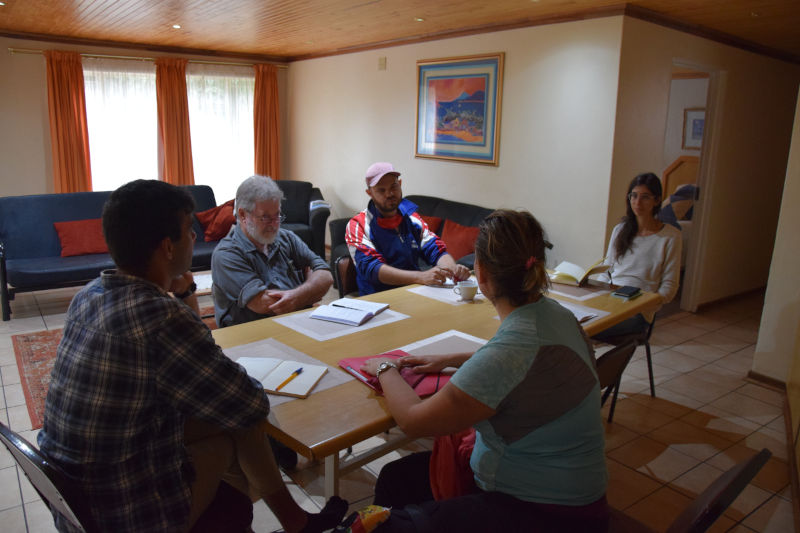

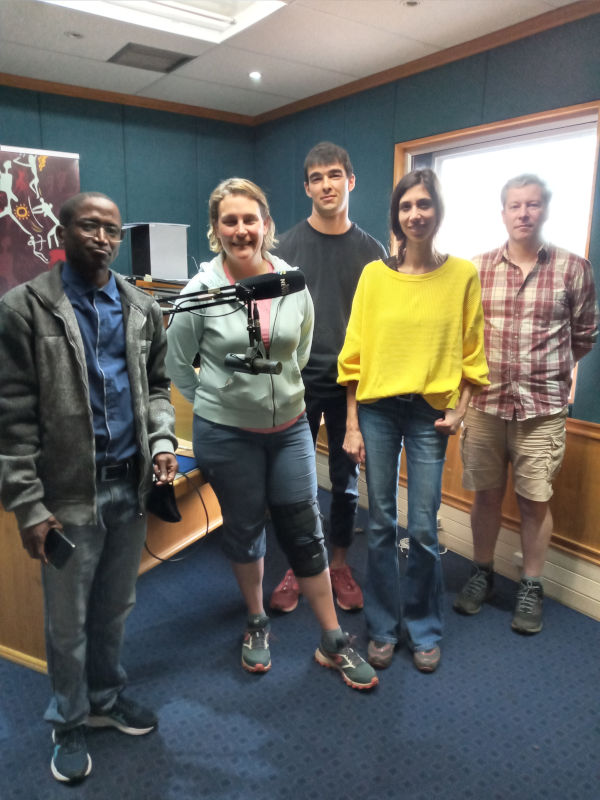
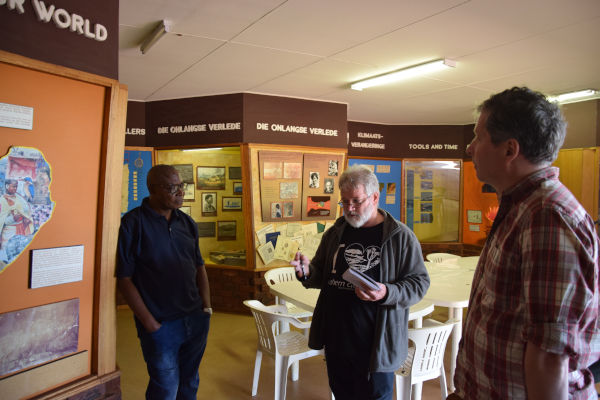


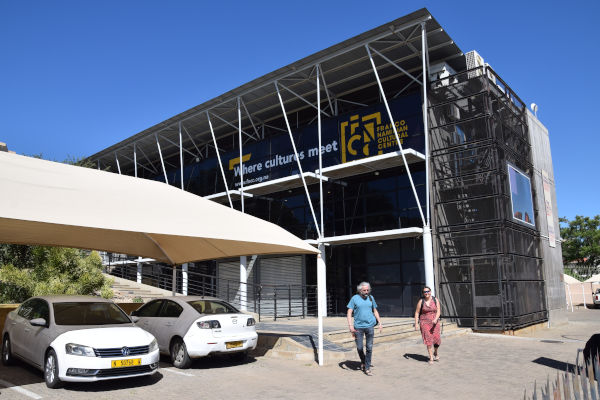
From 13 March to 16 April 2022, Stéphane Hœrlé and Mélanie Duval traveled in South Africa and Namibia to launch COSMO-ART. The objectives were to
- attend the Southern African Montain Conference (SAMC) and give a talk to announce the launch of COSMO-ART;
- meet the COSMO-ART partners in South Africa and Namibia;
- discuss the possibilities of formalising students exchanges with the signature of exchange agreements between partner universities,
- identify additional funding opportunities;
- carry out fieldwork around Kimberley with David Morris (McGregor Museum) and Lourenço Pinto (Sol Plaatje University);
- prepare the fieldwork planned in the Kimberley area for Hugo Quemin’s Master 1 and Leïla Baracchini’s post-doc;
- lay the groundwork for the research activities planned in the Erongo Mountains in Namibia from 2023 onwards. To this end, in the company of David Pleurdeau and Alma Nankela, several days of fieldwork were carried out in the Erongo Mountains.
Tourism construction
- Kimberley, South Africa
- 2 March – 28 May 2022
- Hugo Quemin
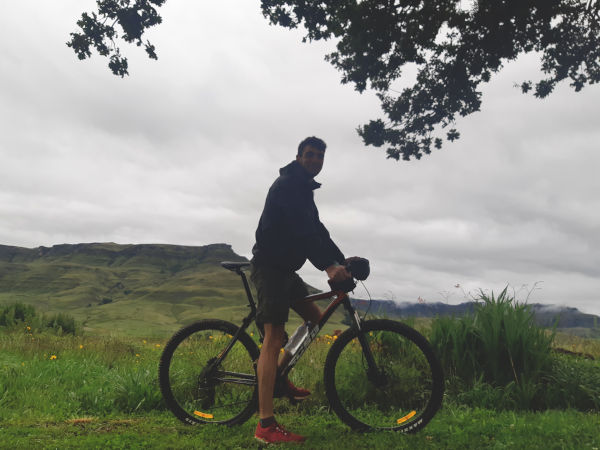
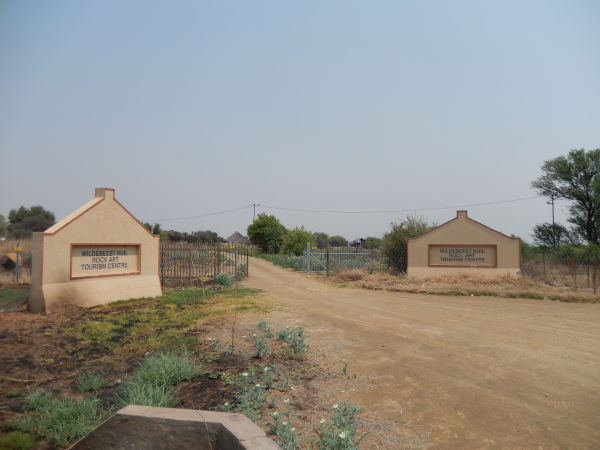
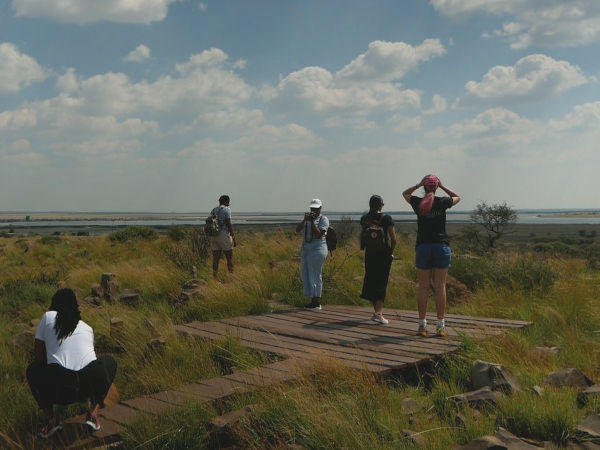
Hugo spent three months in South Africa:
- Two weeks of slow itinerancy to apprehend the actuality of the South African society (1000 km on bike between Pietermaritzburg and Kimberley);
- One and a half month of situated studies, meetings, discussions, participation and data collection, between Kimberley, Cape Town and Johannesburg;
- One month of writing and ongoing discussions and reflections during which some of them proved to be essential to the good establishment of his research.
Earth Day: Rock Art in Discussion
- Windhoek, Namibia
- 22 April 2025
- Mélanie Duval

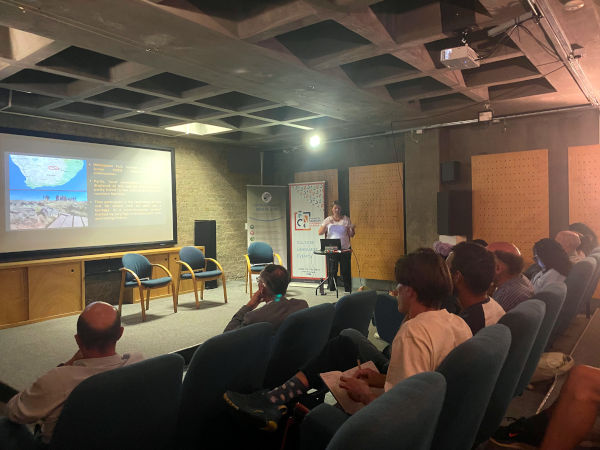
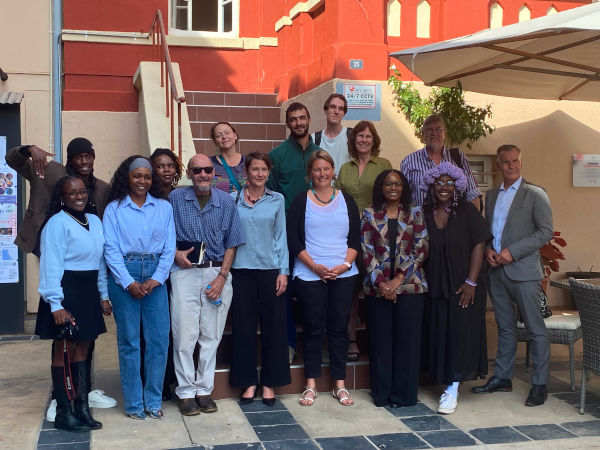
At the invitation of the Franco-Namibian Cultural Centre and as part of the events organised by the Namibia Nature Foundation to celebrate Earth Day, Mélanie Duval was invited to present ongoing research projects related to rock art sites involving Namibian partners.
During a one-hour conference, she introduced the key objectives of the COSMO-ART research project and the RAHMSA international network, encouraging audience members to apply for upcoming workshops in the RAHMSA series.
In the second part of her presentation, she focused on the findings of the COSMO-ART project, particularly the research activities developed within the social sciences and humanities. Over the course of about thirty minutes, she detailed the methods used to analyze stakeholder dynamics surrounding the tourism development of rock art sites in the Erongo Massif and Spitzkoppe, as well as the first research results.
In particular, her presentation highlighted the role of local communities in the implementation of heritage and tourism initiatives in these regions.
The conference was followed by a panel discussion on the recognition of community practices in the management of environmental and cultural resources, featuring Mélanie Duval and Meed Mbidzo, and moderated by Disney Andreas.
Exhibition: Places in Me at the Origins Centre
- Johannesburg, South Africa
- 14 – 15 March 2025
- Leïla Baracchini, Mélanie Duval, Lourenço Pinto & Hugo Quemin
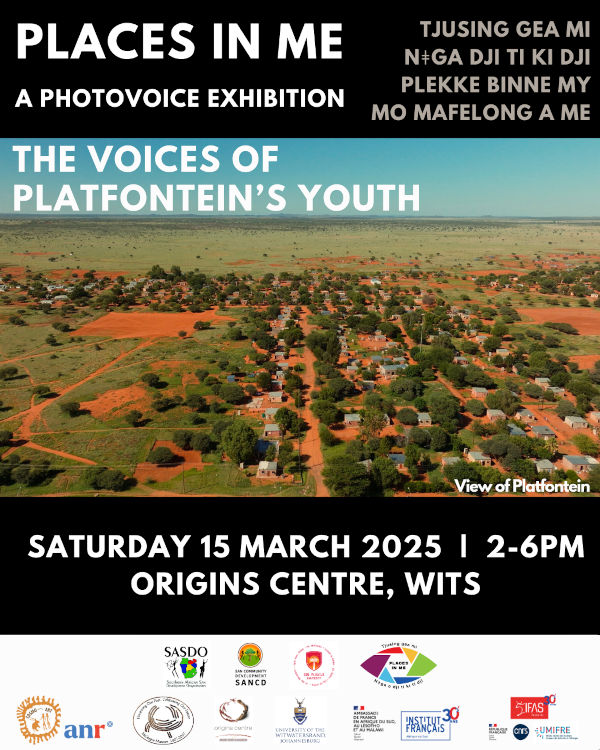
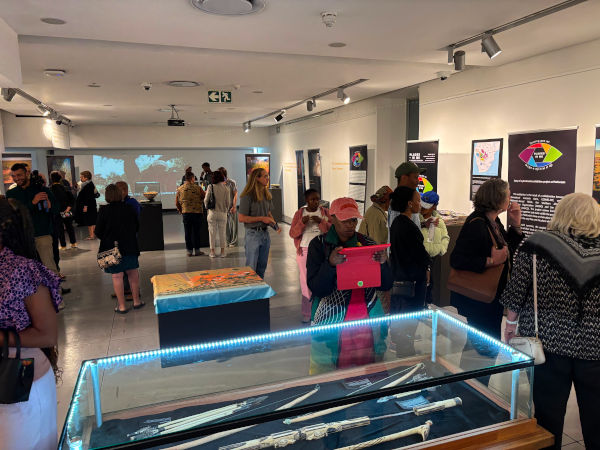
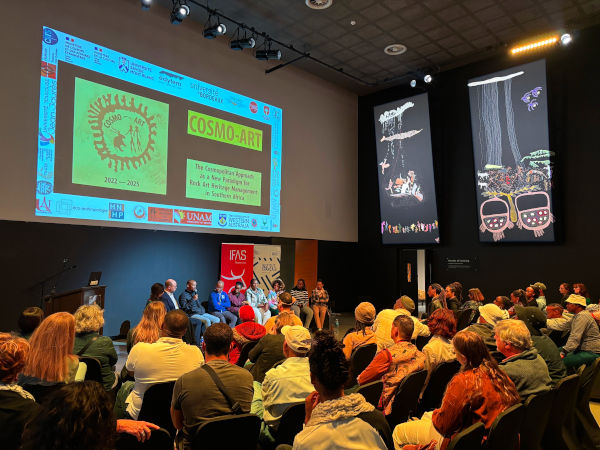
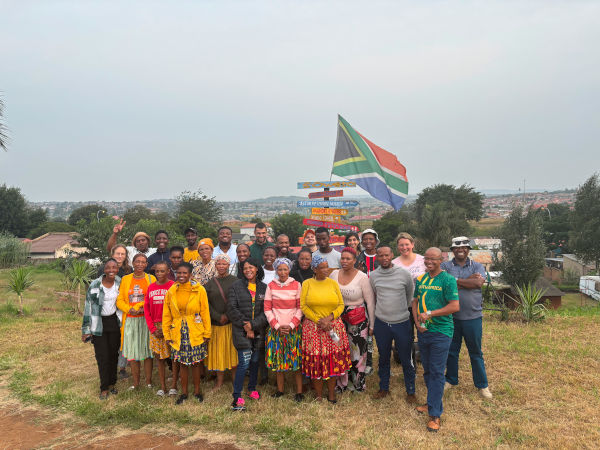
Building on the events organised around the « Places in Me » exhibition in 2023, the objectives for 2025 were:
- to bring the exhibition to the Origins Centre, a museum of national and international renown located on the Witwatersrand University Campus, and
- to take advantage of the exhibition to organise several cultural events focused on contemporary Khwe and !Xun culture.
This opening event and the associated activities are supported by the French Institute of South Africa, IFAS-Research, and the Origins Centre. It is organised by a team bringing together members from COSMO-ART, SANCD (Jakob Makai and Zagaria Kabinda), and SASDO (Moshe and Rena Maghundu).
For its coming to the Origins Centre the exhibition has been enhanced with posters and pull-up banners designed to contextualise the realities of the two San communities of Platfontein, for national and international visitors who may not be familiar with their way of life.
Additionally, the exhibition was enriched with objects from both communities, selected by community members. These items—including necklaces, traditional cooking utensils, and hunting tools—illustrate the intersection between tradition and modernity.
A 20-minute film was also produced, featuring individuals from Platfontein explaining, in Khwedam or !Xuntali, the use and cultural significance of these objects. The film includes English subtitles, with the goal of promoting local languages.
The objective was not only to showcase the exhibition but also to present the photovoice methodology, highlight co-creation processes, and invite the public to discover cultural performances combining tradition and modernity, including dance and hip-hop performances. Furthermore, this event aimed to provide Platfontein people with opportunities to exchange ideas with institutions and individuals who could offer knowledge and perspectives on sustainable community-based cultural tourism.
In collaboration with SASDO and SANCD, a 22-person delegation was formed, ensuring equal representation of the Khwe and !Xun communities. The delegation also included members from both organisations, individuals involved in the photovoice process, translators for both local languages, as well as members of a hip-hop group and a traditional dance troupe.
Upon their arrival in Johannesburg on Friday, March 14, the delegation went to Lebo Backpackers, located in Soweto. This establishment is unique in that it was founded by Lebo, a Soweto resident who successfully engaged and involved the local community in this form of community-based tourism. Numerous discussions took place between the guide and the delegation members regarding training issues and ways to integrate the local population into tourism initiatives.
On the morning of Saturday, March 15, the delegation visited the Origins Centre Museum, followed by a roundtable discussion on the museum’s content. Many discussions focused on the representation of San culture in the museum’s films and the issue of stereotypes in portraying indigenous cultures.
The official opening of the exhibition took place on Saturday afternoon, structured into several key moments:
- Welcome speech by Tammy Hodgskiss, Acting Head and Curator of the Origins Centre.
- Presentation by Mélanie Duval on the scientific objectives of the COSMO-ART project, the co-creation process between communities and researchers, the photovoice project, and the contents of the « Places in Me » exhibition.
- Roundtable discussion, moderated by Leïla Baracchini and Lourenço Pinto, featuring five delegation members and two translators. The discussion focused on the challenges of integrating the !Xun and Khwe communities’ heritage into tourism, with simultaneous translations into the two local languages, !Xuntali and Khwedam.
- Presentation of the exhibition to the public.
- Speeches by Annaël Le Poullennec (Director of IFAS-Research) and Jean Spiri (Director of Cultural Cooperation at the French Embassy in South Africa), both partners in the 2025 exhibition opening project.
- Speech by Itunu Bodunrin, lecturer at the University of Johannesburg, who completed his PhD on Hip Hop performances in Platfontein.
- Cultural performances, including traditional dance (Mushulongo Dance Group) followed by a Hip Hop performance (Khwe Music Production).
The afternoon concluded with a buffet and another opportunity for guests to explore the exhibition.
The exhibition will remain on display at the Origins Centre until May 9, 2025. It will then be showcased again during the final COSMO-ART project conference, which will take place from November 30 to December 6, 2025, at Sol Plaatje University in Kimberley.
Journée de restitution Science et/ou en société
- Paris, France
- 27 September 2024
- Mélanie Duval
Projects supported in 2024 by the CNRS Humanities & Social Sciences Institute (CNRS InSHS) as part of the ‘Science and/or in Societies’ call for projects were presented in Paris on 27 September.
Mélanie Duval presented the research conducted as part of the ANR COSMO-ART and IRN RAHMSA projects, focusing on the photovoice project, the « Places in Me » exhibition and the RAHMSA workshop planned for 2025.
The day’s events were very rich and gave several project coordinators the opportunity to present how researchers work for and/or in society by presenting different working and data collection methods.
The issues surrounding the involvement of participants were at the heart of the discussions, including legal and contractual aspects.
Journée de restitution Science et/ou en société, CNRS, Paris, France, 27 septembre 2024.
Fackelträger 3D-printed replica
- Erongo, Namibia
- September 2024
- Benoît Caron, Kaarina Efraim, Lenishwa Engelbrecht & David Pleurdeau
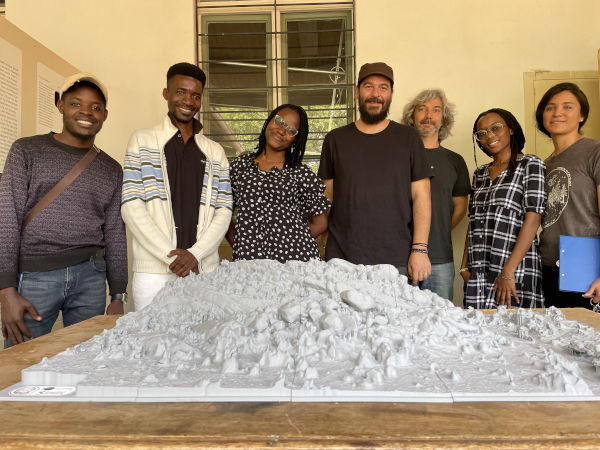
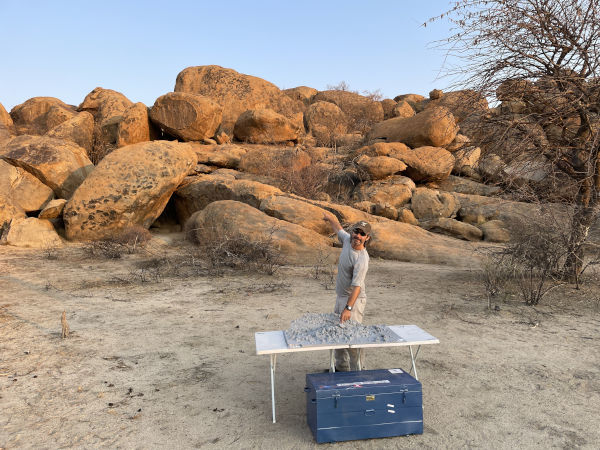
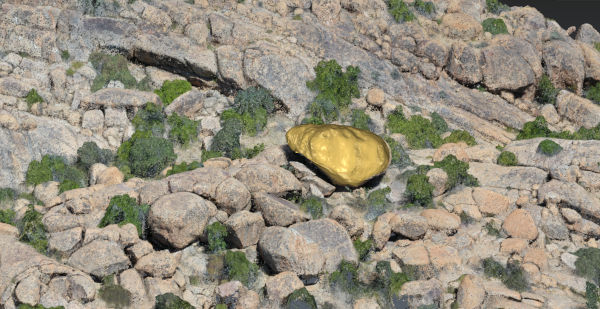
During this trip to Namibia, we had with us a 3D-printed replica of Fackelträger, an important rock art site in the Erongo Mountains.
Stéphane Jaillet, Benoît Caron and the entire team acquired the imagery and geomorphology data using drones and LiDAR (projects funded by the French Ministry of Foreign Affairs, the ANR COSMO-ART and the ANR Color Sources programmes).
Over the course of a year and a half, the Fablab Sorbonne Université team (Pierre Thery, Stéphane Muller and Étienne Visinoni) printed the 3D model in 18 pieces. The model covers an area of just under three hectares.
What makes this achievement so exceptional are its size, definition and resolution!
The model was originally intended for an exhibition at the Franco-Namibian Cultural Centre (FNCC) in Windhoek to ‘bring the field’ to the capital. It also enables visually impaired people to better understand the rock art surfaces.
It was first displayed at the National Museum of Namibia and then at the site itself, where it was inaugurated by the French ambassador. It will be part of an exhibition in the Erongo Mountains and may travel further.
Séminaires ErasmusAfric’Arch
& Afriques au Pluriel
- Toulouse, France
- 18 March 2024
- Mélanie Duval
Invited to take part in the ErasmusAfric’Arh and Afriques au Pluriel seminars series, Mélanie Duval outlined the objectives of the COSMO-ART project and some of the methods used to understand the diversity of viewpoints and positions when talking about heritage. After a brief presentation of the theoretical underpinning of the programme and its organisation into workpackages, the presentation focused on the research carried out on the Wildebeest Kuil site (South Africa).
An in-depth presentation of the photovoice project conducted with young Khwe and !Xun people over the year 2023 and the resulting travelling exhibition led to a discussion of the contributions and limitations of this type of approach. In conclusion, the links between the ANR COSMO-ART project and the IRN RAHMSA were explained.
In conclusion, the links between the ANR COSMO-ART project and the IRN RAHMSA were explained.
Séminaires ErasmusAfric’Arch
& Afriques au Pluriel, Université Jean-Jaurès, Toulouse, 18-22 mars 2024.
Conservation of the Wonderwerk Cave paintings (Northern Cape, South Africa)
- Sol Plaatje University, South Africa
- 6 December 2023
- Anaïs Empereur-Buisson
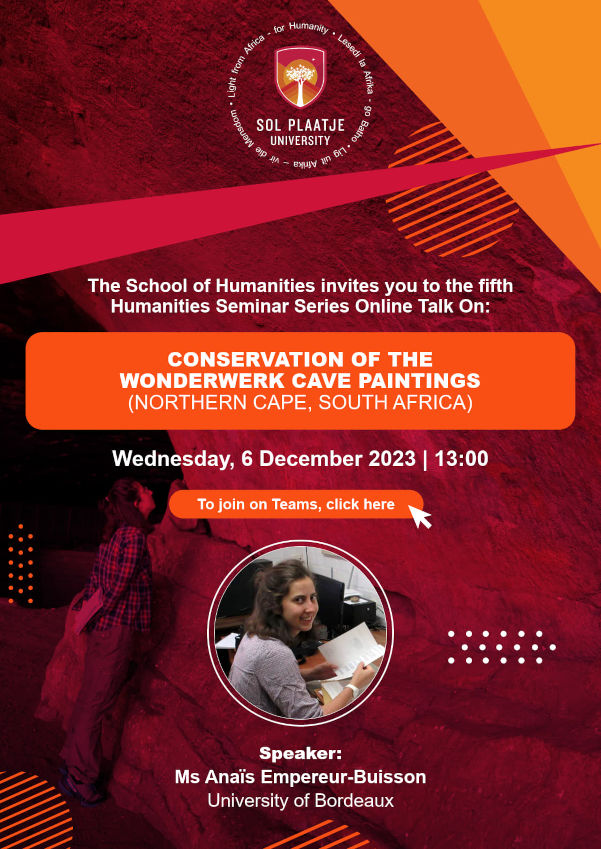
Anaïs Empereur-Buisson gave a talk on the research project she carried out to obtain her Masters 2 degree in Archaeology & Science for Archaeology, specialty in Prehistory Geoarchaeology and Archaeozoology, at the University of Bordeaux.
5th Humanities Seminar Series Online Talk, Sol Plaatje University, South Africa, 6 December 2023.
Café Science EDYTEM
- Chambéry, France
- 26 October 2023
- Mélanie Duval
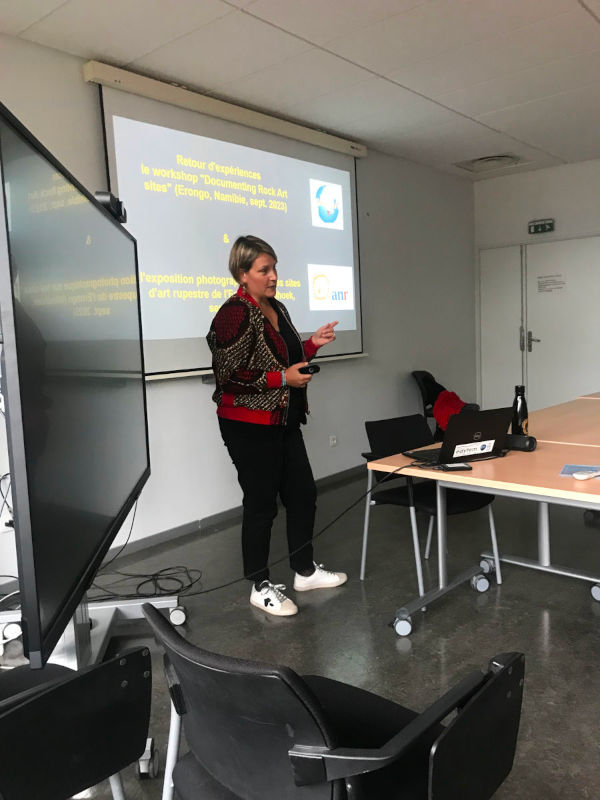
The objective of the Café Science events organised every Thursday at EDYTEM is to explain the main lines of ongoing research projects, recently obtained results or newly published publications.
Mélanie Duval presented to the staff and students of EDYTEM the last activities of COSMO-ART and its sister project RAHMSA in Namibia: « Documenting Rock Art sites », the first installment in the RAHMSA Training Workshop Series, and the exhibition « A Tribute to Rock Art in Namibia » that was specially prepared for the last Namibian Heritage Week.
GDR Rift Webinars
- Online, France
- 6 October 2023
- Mélanie Duval
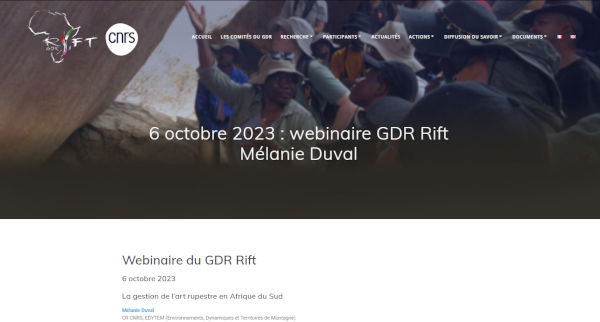
The Great African Rift Interdisciplinary Group (GDR Rift) is an inter-institute structure which federates the communities of the CNRS Ecology & Environment (InEE), CNRS Humanities & Social Sciences (InSHS), CNRS Earth & Space (InSU) institutes around the Great African Rift. The main goal is to characterise the interrelationships within this complex system including living organisms (including humans), geodynamic and climate processes.
Mélanie Duval gave an online talk as part on the GDR Rift Webinars series where she discussed the management of rock art in South Africa and presented the activities of COSMO-ART and RAHMSA.
Exhibition: A tribute to Rock Art in Namibia
- Windhoek, Namibia
- 18 – 29 September 2023
- Mélanie Duval, Kaarina Efraim, Lenishwa Engelbrecht, Stéphane Hœrlé, Julien Monney, Alma Nankela & David Pleurdeau
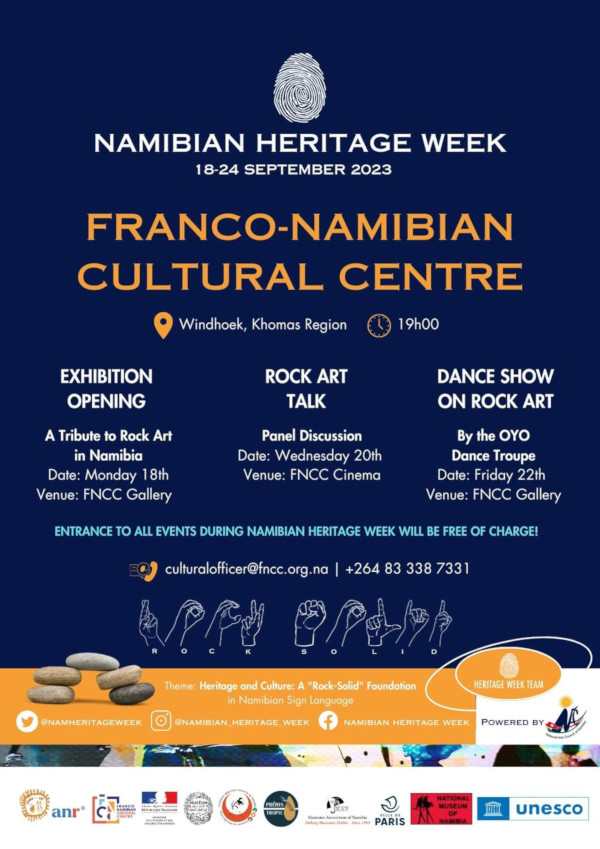
The exhibition was hosted by the Franco Namibian Cultural Centre (FNCC) and was prepared in collaboration or with the support of the FNCC, Ministère de l’Europe et des Affaires Etrangères, the Muséum national d’histoire naturelle, the National Heritage Council of Namibia, Préhistropic, the Museums Association of Namibia, la Ville de Paris, the National Museum of Namibia and the UNESCO office in Windhoek.
As a graphic creation, Namibian rock art is a cultural expression of people who inhabited a large part of southern Africa. Namibia has several areas with high concentrations of rock art sites, including paintings and engravings. The well-known locality is in Central Namibia including Twyfelfontein World Heritage Site and the Brandberg Mountains. While these ones are often cited as examples, the archaeological landscape of the Erongo Mountains is little known to the general public. Linked with COSMO-ART and the research carried out by archaeologists in this region for many years (Alma Nankela, David Pleurdeau and his team, etc.), the exhibition aims to bring about the quality of Erongo rock art heritage to the attention of the Namibian public.
The exhibition showcases large prints of rock art sites in the Erongo Mountains to highlight the symbolic expressions and high graphic quality of the paintings. This discovery of rock art sites is also accompanied by an exhibition of archaeological objects excavated at several rock art sites by archaeologists working in these mountains to date. These objects provide unparalleled insights into themes within the hunter-gatherers’ tradition and better understanding of the culture of the people who produced this rock art.
In addition to an artistic dimension, the exhibition also has educational aims, with an expression corner and activities organised for school children.
Finally, the goal is to use the exhibition as an opportunity to discuss the complex challenges in preserving rock art heritage in Namibia and developing rock art sites for tourism, including the involvement of local communities and the sharing of benefits. Therefore, a panel discussion event was held on Wednesday 20 September.
To close the national heritage week, the exhibition space hosted a performance by the OYO dance group, combining the art of dance with that of the graphic arts.
Exhibition: Places in Me
- Kimberley, South Africa
- 1 July 2023 – 30 September 2023
- Leïla Baracchini, Lucas Bruchet, Mélanie Duval, Abenicia Henderson, Stéphane Hœrlé, Lourenço Pinto & David Morris
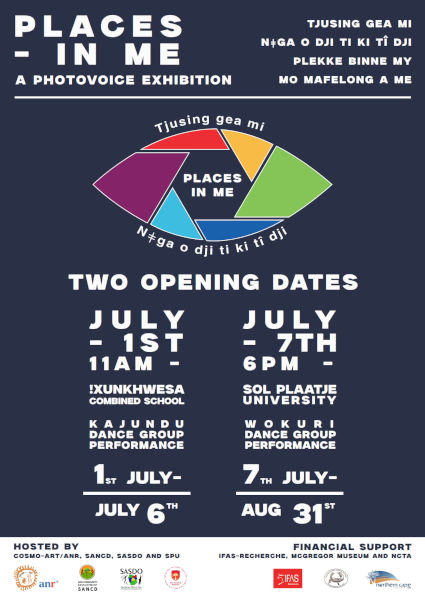
This exhibition project is the result of a collaboration between COSMO-ART and two Platfontein-based NPOs, the Southern African the San Community Development (SANCD) and the San Development Organisation (SASDO) and. It is based on a participatory photography experiment, called photovoice, which was conducted by Leïla Baracchini, a post-doctoral fellow in the Cosmo-Art project, for several months in 2022 with a group of 15 young Platfontein residents, aged between 18 and 30.
The exhibition is supported by the French Institute in South Africa (IFAS-Recherche), the Northern Cape Tourism Authority and the McGregor Museum and is organised by a team joining forces from COSMO-ART, SANCD (Jakob Makai and Zagaria Kabinda) and SASDO (Moshe and Rena Maghundu).
The project is based on a common desire to capture and make visible the perspective that young people in Platfontein have of their place in South African society through the eyes of the place they live.
Equipped with photo cameras, they were asked to document different aspects of their local environment that are important, relevant and interesting to them. On the basis of the pictures taken, interviews conducted by Leïla Baracchini made it possible to collect their points of view on the pictures taken. Composed of about twenty roll-up banners, the exhibition proposes a dialogue between the photos taken and extracts from the authors’ speeches on their own work.
Their photographs and texts speak to us of beauty, suffering, aspirations and disappointments, of shifting identities. In this visual exploration, the images capture and convey their individual perspectives, how they see themselves, how they define and relate to the world, and what they perceive as important or different.
The preparation of the exhibition was the opportunity to involve students from the Sol Plaatje University and use this dissemination action as teaching material.
The Places in Me exhibition opened on 1 July 2023 at the !Xunkhwesa Combined School in Platfontein and then moved to Sol Plaatje University and the William Humphreys Art Gallery in Kimberley. It is planned that the exhibition circulates then between various venues: such as the Origins Centre in Johannesburg or the !Khwa ttu San Heritage Centre in Yzerfontein. The design of the exhibition in the form of roll-up banners is intended to allow easy circulation of the exhibition.
Café Science at EDYTEM
- Chambéry, France
- 19 May 2022
- Mélanie Duval
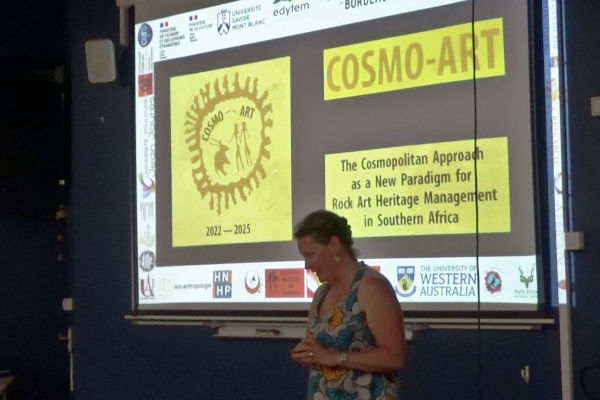
In a short format (20 minutes), the objective of the Café Science events organised every Thursday at the EDYTEM laboratory is to explain the main lines of ongoing research projects, recently obtained results or newly published publications.
After having contextualised the issues associated with the management of rock art sites in southern Africa, and underlined the difficulties of taking into account a diversity of practices and perceptions, Mélanie Duval presented the scientific objectives of the COSMO-ART project, its structuring into workpackages, the study areas selected, as well as the research actions undertaken for 2022 and those announced for 2023.
RTS FM Ma’at Reggae Show
- Kimberley, South Africa
- 26 March 2022
- Leïla Baracchini, Mélanie Duval, Stéphane Hœrlé & Hugo Quemin
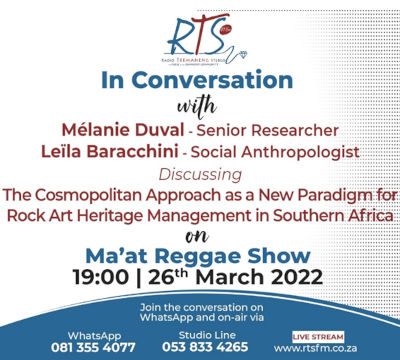

Between two reggae tunes, a COSMO-ART team explained the aims of the project at RTSfm, a radio station in Kimberley. They talked about the upcoming photo exhibition (using the data collected through the photovoice project run by Leïla Baracchini), rock art sites preservation issues and how cultural heritage may help to develop tourism in the Northern Cape region.
Interview at X-K FM
- Kimberley, South Africa
- 23 March 2022
- Leïla Baracchini, Mélanie Duval & Hugo Quemin
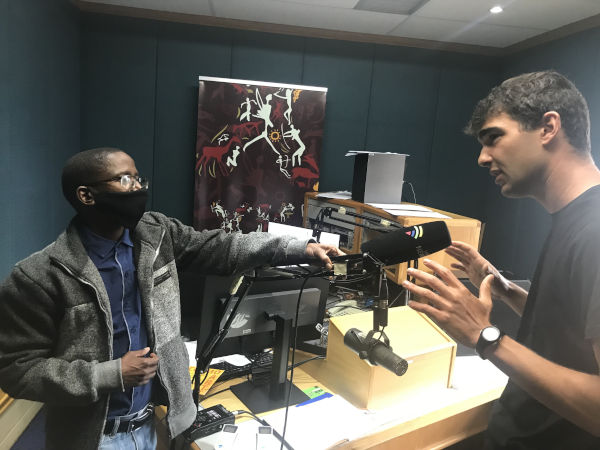
Guests at Platfontein by the X-K FM Community Radio, Hugo, Leïla and Mélanie presented the main lines of the COSMO-ART project, with particular emphasis on the actions that will be undertaken during the four years of the project on the rock art sites of the Kimberley region. A first announcement concerning the photovoice project was also made. Broadcast in the two community languages, this talk on the local radio allowed the objectives of the project to be better known to the two local populations. Broadcast on local radio in the two community languages, the talk helped to raise awareness of the project’s aims among the two local communities.
